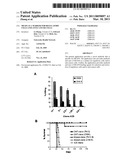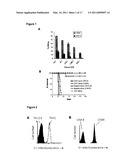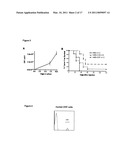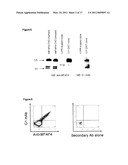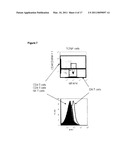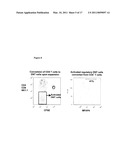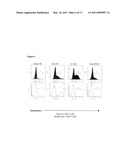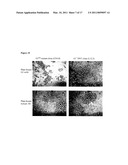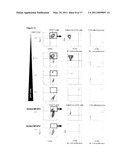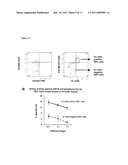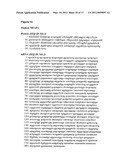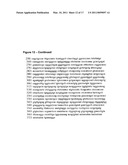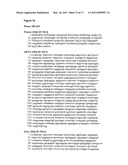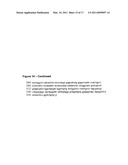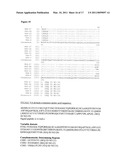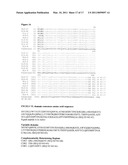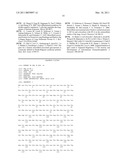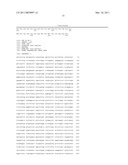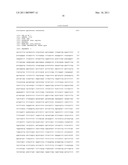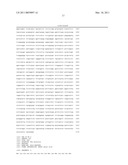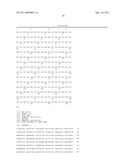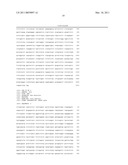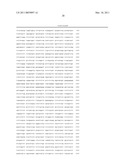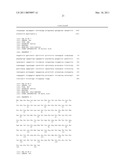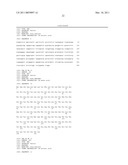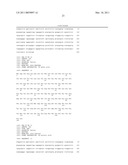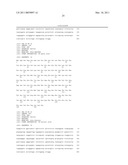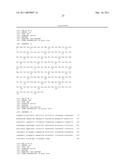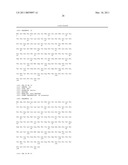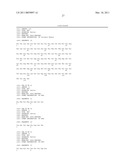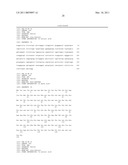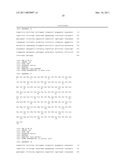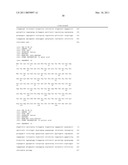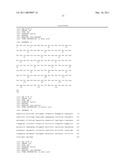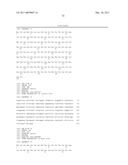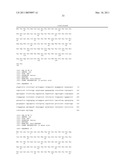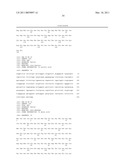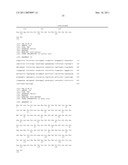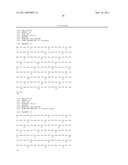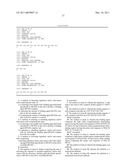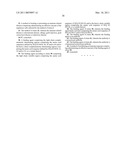Patent application title: MFAP4 as a Marker For Regulatory Cells and Anti-Cancer Cells
Inventors:
Li Zhang (Toronto, CA)
Edward Kim (Toronto, CA)
Betty Joe (Toronto, CA)
IPC8 Class: AA61K39395FI
USPC Class:
4241411
Class name: Drug, bio-affecting and body treating compositions immunoglobulin, antiserum, antibody, or antibody fragment, except conjugate or complex of the same with nonimmunoglobulin material monoclonal antibody or fragment thereof (i.e., produced by any cloning technology)
Publication date: 2011-03-10
Patent application number: 20110059097
Claims:
1. A method of detecting regulatory and/or anti-cancer cells comprising
the steps of:(1) contacting a test sample with a binding agent that binds
specifically to MFAP4 on the cell to produce a binding agent-MFAP4
complex;(2) detecting the amount of binding agent-MFAP4 complex in the
test sample; and(3) comparing the amount of binding agent-MFAP4 complex
in the test sample to a control.
2. A method of selecting or enriching regulatory and/or anti-cancer cells comprising the steps:(1) contacting a test sample with a binding agent that binds specifically to MFAP4 on the cell to produce a binding agent-MFAP4 complex; and(2) selecting or enriching regulatory and/or anti-cancer cells by selecting the binding agent-MFAP4 complex from the test sample.
3. A method of activating regulatory and/or anti-cancer cells comprising:contacting regulatory and/or anti-cancer cells with a binding agent that binds specifically to MFAP4 on the cell to crosslink MFAP4.
4. (canceled)
5. The method of claim 2, further comprising the step of activating the selected or enriched regulatory and/or anti-cancer cells by allowing a binding agent that binds specifically to MFAP4 on the cell to crosslink MFAP4.
6. (canceled)
7. The method of claim 2, wherein the regulatory T cells and/or anti-cancer cells comprise double negative T (DNT) cells.
8. The method of claim 7, wherein the double negative T cells comprise cells that are CD3.sup.+TCR+CD4.sup.-CD8.sup.-.
9. The method of claim 8, wherein the double negative T cells comprise cells that are CD3.sup.+αβTCR+CD4.sup.-CD8.sup.-.
10-14. (canceled)
15. The method of claim 2, wherein the binding agent comprises the light chain complementarity determining regions having the amino acid sequence of SEQ ID NOS: 44, 45, and/or 46, and/or the heavy chain complementarity determining regions having the amino acid sequence of SEQ ID NOS: 21, 22 and/or 23.
16-17. (canceled)
18. The method of claim 2, wherein the binding agent comprises a light chain variable region comprising the amino acid sequence of SEQ ID NO: 20 and a heavy chain variable region comprising the amino acid sequence of SEQ ID NO:43.
19. The method of claim 2, wherein the binding agent is an antibody.
20. The method of claim 19, wherein the antibody is a monoclonal antibody.
21. The method of claim 19, wherein the antibody is a humanized monoclonal antibody.
22. A method of treating or preventing an immune related disease comprising administering an effective amount of the regulatory cells selected by the method of claim 2.
23. The method of claim 22, wherein the immune related disease is autoimmune disease, allergy, graft rejection, graft versus host disease or infectious disease.
24-37. (canceled)
38. A binding agent comprising the light chain complementarity determining regions comprising the amino acid sequences defined by SEQ ID NOS: 44, 45 and/or 46 and/or the heavy chain complementarity determining regions comprising the amino acid sequence defined by SEQ ID NOS: 21, 22 and/or 23, or a variant thereof.
39. The binding agent according to claim 38 comprising the light chain variable region comprising the amino acid sequence of SEQ ID NO:43 and/or the heavy chain variable region comprising the amino acid sequence of SEQ ID NO:20, or a variant thereof.
40. The binding agent of claim 38, wherein the binding agent binds a protein comprising the amino acid sequence of SEQ ID NO:1 and/or SEQ ID NO:4.
41. The binding agent of claim 38, wherein the binding agent is an antibody.
42. The binding agent of claim 41, wherein the antibody is a monoclonal antibody.
43. The binding agent of claim 41, wherein the antibody is a humanized monoclonal antibody.
44. A method of modulating an immune response comprising administering an effective amount of the binding agent of claim 38.
45. (canceled)
Description:
FIELD
[0001]The present application relates to a novel antibody, and methods of use thereof. Further, the application relates to methods and uses of MFAP4 as a marker for regulatory cells and anti-cancer cells. The application also relates to MFAP4 binding agents and methods and uses for selecting and activating regulatory cells and anti-cancer cells.
BACKGROUND
[0002]Over the past 20 years, short-term allograft survival has been improved significantly with the advent of immunosuppressive drugs. However, the deterioration of drug efficacy over a prolonged period of time renders them ineffective in preventing chronic graft rejection. Moreover, immunosuppressive drugs render patients susceptible to infections and malignancy. A major goal of transplantation is to induce long-term transplant tolerance without impairing the recipient immune system. Many studies have established the critical role of regulatory T cells in immune tolerance.
[0003]The inventors have previously identified and cloned a novel regulatory subset of αβTCR+CD4-CD8- T (DNT) cells and demonstrated that these cells can kill activated antigen-specific CD4+ and CD8+ effector T cells in vitro and in vivo (1-5). Adoptive transfer of DNT regulatory cells activated by donor-lymphocyte infusion can potently suppress anti-donor T cell responses in vivo, leading to long-lasting tolerance to transplants (1-5). The inventors have also demonstrated the suppression of autoreactive T cells by DNT regulatory cells in an animal model of autoimmune diabetes, in which peptides activated DNT regulatory cells provided protection against auto-reactive T cells specific for an antigen expressed in pancreatic islets (6). In addition, the inventors have demonstrated that DNT cells have potent anti-cancer effect (7).
[0004]DNT cells comprise only ˜1% of PBMC, and no unique surface markers have been identified to positively select DNT cells. Current ex vivo expansion methods for DNT cells rely on depleting multiple subsets from the starting population. Moreover, there are no known functional markers that can distinguish potent suppressive DNT cells within a heterogeneous population during their activation and expansion. The lack of a reliable cell surface marker extends to other regulatory T cell subsets such as CD4+CD25+Foxp3+ T regulatory cells, CD4+CD25+ T regulatory cells, CD8+CD28- T regulatory cells, T regulatory-1 cells, T helper-3 cells, and regulatory NKT cells (reviewed in 8). This makes it difficult to phenotypically distinguish T regulatory cells from other activated effector or memory T cells. For instance, it is still not clear whether Foxp3 is a specific marker for T regulatory cells in humans because activated T cells can transiently express Foxp3 albeit at lower levels than natural CD25hiCD4+ T regulatory cells (8). Moreover, Foxp3 is an intracellular molecule whose detection renders cells non-functional for applications subsequent to cell sorting. Other molecules such as CD25, CTLA-4, GITR, and CD127 can be used as cell surface markers for natural CD4+CD25+ T regulatory cells, however they are unable to fully distinguish natural T regulatory cells from activated T cells because all T cells express these molecules upon activation (8).
[0005]Thus, there is a need for methods of detecting and selecting or isolating regulatory cells.
SUMMARY
[0006]The present inventors have identified and developed a novel antibody. Specifically, the inventors have identified and developed a novel antibody that binds MFAP4. Further, the inventors have identified that MFAP4 is expressed on the surface of a subset of regulatory cells and anti-cancer cells. Thus, MFAP4 can be used as a marker to detect, enrich and/or select regulatory cells and/or anti-cancer cells. In addition, the inventors have shown that the regulatory cells and anti-cancer cells can be activated by binding of MFAP4. The activated regulatory cells can be used to treat or prevent the progression of many types of immune-related diseases, such as graft rejection, graft-versus-host disease, autoimmune disease, allergic diseases and infectious disease. The activated anti-cancer cells can be used to treat or prevent the progression of cancer.
[0007]The inventors have cloned and sequenced a novel antibody that specifically binds MFAP4 and determined the sequence of the light and heavy chain variable regions and complementarity determining regions 1, 2 and 3 of the antibody.
[0008]Accordingly, the application discloses isolated light chain complementarity determining region 1 (CDR1) comprising the amino acid sequence QSLLSSGNQKNY (SEQ ID NO:44); isolated light chain complementarity determining region 2 (CDR2) comprising the amino acid sequence YSS (SEQ ID NO:45); and isolated light chain complementarity determining region 3 (CDR3) comprising the amino acid sequence LQHYSSPFT (SEQ ID NO:46); and isolated heavy chain CDR1 comprising the amino acid sequence GFPFSNYG (SEQ ID NO:21); isolated heavy chain CDR2 comprising the amino acid sequence ISYDGRST (SEQ ID NO:22) and isolated heavy chain CDR3 comprising the amino acid sequence VRHELPEDH (SEQ ID NO:23).
[0009]The application also discloses isolated nucleic acid sequences encoding the light chain complementarity determining region 1 (CDR1) comprising the amino acid sequence QSLLSSGNQKNY (SEQ ID NO:44); the light chain complementarity determining region 2 (CDR2) comprising the amino acid sequence YSS (SEQ ID NO:45); and the light chain complementarity determining region 3 (CDR3) comprising the amino acid sequence LQHYSSPFT (SEQ ID NO:46); and the heavy chain CDR1 comprising the amino acid sequence GFPFSNYG (SEQ ID NO:21); the heavy chain CDR2 comprising the amino acid sequence ISYDGRST (SEQ ID NO:22); and the heavy chain CDR3 comprising the amino acid sequence VRHELPEDH (SEQ ID NO:23).
[0010]Additional aspects disclosed in the present application are isolated light chain variable regions comprising light chain CDR1, CDR2 and/or CDR3 disclosed herein (SEQ ID NOS:44, 45 and/or 46), and isolated heavy chain variable regions comprising heavy chain CDR1, CDR2 and/or CDR3 disclosed herein (SEQ ID NOS:21, 22 and/or 23). In one embodiment, the light chain variable region comprises the amino acid sequence shown in FIG. 16 (SEQ ID NO:43). In another embodiment, the heavy chain variable region comprises the amino acid sequence shown in FIG. 15 (SEQ ID NO:20).
[0011]Another aspect of the present application is a novel binding agent that specifically binds MFAP4, that comprises at least one light chain complementarity determining region disclosed herein (i.e. one or more of SEQ ID NOs:44-46) and/or at least one heavy chain complementarity determining region disclosed herein (i.e. one or more of SEQ ID NOs:21-23). In one embodiment, the binding agent comprises the light chain variable region of SEQ ID NO:43 and the heavy chain variable region of SEQ ID NO:20. In yet a further embodiment, the binding agent is an antibody. In another embodiment, the binding agent is a monoclonal antibody. In yet a further embodiment, the monoclonal antibody is a monoclonal antibody termed G1.
[0012]Further, the application provides a method of detecting regulatory and/or anti-cancer cells comprising the steps of: [0013](1) contacting a test sample with a binding agent that binds specifically to MFAP4 on the cell to produce a binding agent-MFAP4 complex; [0014](2) detecting the amount of binding agent-MFAP4 complex in the test sample; and [0015](3) comparing the amount of binding agent-MFAP4 complex in the test sample to a control.
[0016]In addition, the application provides a method of selecting or enriching regulatory and/or anti-cancer cells comprising the steps: [0017](1) contacting a test sample with a binding agent that binds specifically to MFAP4 on the cell to produce a binding agent-MFAP4 complex; and [0018](2) selecting or enriching regulatory and/or anti-cancer cells by selecting the binding agent-MFAP4 complex from the test sample.
[0019]The application also provides a method of activating regulatory and/or anti-cancer cells comprising: [0020]contacting regulatory and/or anti-cancer cells with a binding agent that binds specifically to MFAP4 on the cell to crosslink MFAP4.
[0021]In one embodiment, the cells are contacted in vitro.
[0022]In one specific embodiment, the novel binding agent disclosed herein is the binding agent for the methods disclosed herein.
[0023]In another aspect, the application provides use of an MFAP4-selected or -activated regulatory cell obtained by the method of the application for treating or preventing an immune-related disease. The application also provides a method of treating or preventing an immune-related disease comprising administering an MFAP4-selected or -activated regulatory cell obtained by the method of the application to an animal in need thereof. The application further provides use of an MFAP4-selected or -activated regulatory cell in the preparation of a medicament for treating or preventing an immune-related disease. The application also provides an MFAP4-selected or -activated regulatory cell obtained by the method of the application for use in the treatment or prevention of an immune-related disease.
[0024]In yet another aspect, the application provides use of an MFAP4-selected or -activated anti-cancer cell obtained by the method of the application for treating or preventing a cancer. The application also provides a method of treating or preventing a cancer comprising administering an MFAP4-selected or -activated anti-cancer cell obtained by the method of the application to an animal in need thereof. The application further provides use of an MFAP4-selected or -activated anti-cancer cell in the preparation of a medicament for treating or preventing a cancer. The application also provides an MFAP4-selected or -activated anti-cancer cell obtained by the method of the application for use in the treatment or prevention of a cancer.
[0025]In a further aspect, the application provides a method of modulating an immune response in an animal comprising administering an effective amount of an MFAP4 binding agent to an animal in need thereof. The application also provides a use of an effective amount of an MFAP4 binding agent for modulating an immune response in an animal in need thereof. The application further provides a use of an effective amount of an MFAP4 binding agent in the preparation of a medicament for modulating an immune response. The application yet further provides an MFAP4 binding agent for use in modulation of an immune response.
[0026]In another aspect, the present application provides a method of modulating cancer in an animal comprising administering an effective amount of an MFAP4 binding agent to an animal in need thereof. The application also provides a use of an effective amount of an MFAP4 binding agent for modulating cancer in an animal in need thereof. The application further provides a use of an effective amount of an MFAP4 binding agent in the preparation of a medicament for modulating cancer. The application yet further provides an MFAP4 binding agent for use in modulation of cancer.
[0027]Other features and advantages of the present disclosure will become apparent from the following detailed description. It should be understood, however, that the detailed description and the specific examples while indicating preferred embodiments of the disclosure are given by way of illustration only, since various changes and modifications within the spirit and scope of the disclosure will become apparent to those skilled in the art from this detailed description.
BRIEF DESCRIPTION OF THE DRAWINGS
[0028]The disclosure will now be described in relation to the drawings in which:
[0029]FIG. 1 shows that DNT cell clones but not their mutants can kill A20 B cell lymphoma in vitro and protect against lethal dose of A20 after adoptive transfer in vivo. (A) DNT cell clone CN04 and its natural mutant clone CN48 were used as effector cells at indicated ratios. A20 tumour cells were used as targets in a standard 51Cr release assay. (B) Mice were injected with a lethal dose of A20 tumor cells either alone or together with 5×105 DNT cell clones or their mutants as indicated. Percent tumor-free survival in each group is shown. Each group contains 5-12 mice.
[0030]FIG. 2 shows that G1 mAb selectively stains tumor-reactive and regulatory DNT cell clones, but not their non-functional mutants. (A) DNT cell clone TN12 (unfilled red line, labeled TN12) and its natural mutant TN12.8 (filled black histogram, labeled TN12.8), which has lost cytotoxicity against tumor cells and allo-reactive T cells, were immunostained with G1 mAb and analyzed by flow cytotometry. (B) Immunostaining of another functional DNT cell clone, CN04 (filled histogram labeled CN04), and its natural mutant CN4.8 (filled histogram labeled CN4.8), which has lost cytotoxicity against tumor cells and allo-reactive T cells, with G1 mAb.
[0031]FIG. 3 shows ex vivo expansion of DNT cells from PBMC of healthy donors and their anti-tumor function in a xenograft tumor model. (A) Number of DNT cells after 10 days of ex vivo expansion from 5-10 ml of whole blood (n=10). (B) Ex vivo-expanded human DNT cells can inhibit human lung cancer progression in NOD-SCID mice. NOD-SCID mice were subcutaneously injected with 106H460 tumor cells either alone or together with 5×106 ex vivo-expanded CD8+ or DNT cells. Percent tumor free survival of the recipients is shown. P=0.0436 between DNT versus CD8 T cell-treated groups.
[0032]FIG. 4 shows that G1 mAb selectively immunostains a subset of ex vivo-expanded human DNT cells. Ten days after expansion ex vivo, human DNT cells were immunostained with G1 mAb and analyzed by flow cytometry.
[0033]FIG. 5 shows the validation of MFAP4 as the molecule recognized by the functional marker-specific G1 mAb. MFAP4 was identified by sequencing the protein band derived from immunoprecipitating G1+ DNT cell clone lysates with G1 mAb. The protein recognized by G1 mAb and anti-MFAP4 mAb are of the same molecular sizes as determined by western blot. Recombinant mouse and human MFAP4 proteins were expressed in CHO cells and whole cell lysates were prepared as positive controls for Western blot analysis using anti-MFAP4 mAb. MFAP4 is expressed by functional G1+ DNT cell clones but not G1- DNT cell mutant clones that have lost cytotoxicity against tumor cells and allo-reactive T cells.
[0034]FIG. 6 shows that the molecule recognized by the functional marker-specific G1 mAb is specifically detected on the same activated DNT cell that expresses MFAP4, recognized by anti-MFAP4 mAb. DNT cells were purified from B6 mice, activated in vitro for 5 days, and subsequently co-immunostained with G1 mAb and anti-MFAP4 mAb and analyzed by flow cytometry.
[0035]FIG. 7 shows that MFAP4 is expressed by a subset of activated DNT cells. Lymph node and spleen cells from B6.lpr mice (in which the majority of CD4 and CD8 T cells were depleted ex vivo) were activated in vitro for 5 days using alloantigen stimulation (irradiated [B6×Balb/c]F1 splenocytes), subsequently immunostained with anti-MFAP4, anti-TCRβ, anti-CD4, anti-CD8, and anti-NK1.1 antibodies, and then analyzed by flow cytometry. Dot plot (top) is gated on βTCR+ cells; top highlighted box in the dot plot corresponds to CD4+, CD8+, NK1.1+ (βTCR+ cells, within which the smaller top box corresponds to MFAP4+ cells; bottom highlighted box corresponds to CD4-, CD8-, NK1.1- TCRβ+ cells (DNT cells), within which the smaller bottom box corresponds to MFAP4+ cells. Histogram plot (bottom) is gated on βTCR+ cells and shows MFAP4 expression on CD4/CD8/NK1.1+ cells (filled light gray histogram), DNT cells (bold black line), and unstained control (dark gray histogram).
[0036]FIG. 8 shows MFAP4 is expressed by a subset of regulatory DNT cells converted from allo-activated CD4+ T cells. Purified CD4+ T cells from B6.Thy1.1 mice were labeled with the proliferation-tracking dye CFSE and activated in vitro for 6 days by alloantigen stimulation (mature bone marrow-derived dendritic cells from [B6×Balb/c]F1 mice), subsequently immunostained with anti-MFAP4, anti-βTCR, anti-CD4, anti-CD8, and anti-NK1.1, and then analyzed by flow cytometry. Contour plot (left) is gated on αβTCR+ cells; highlighted box within the contour plot corresponds to CD4-, CD8-, NK1.1-, αβTCR+ cells (DNT cells). Histogram plot (right) shows MFAP4 expression gated on activated DNT cells based on the contour plot (left).
[0037]FIG. 9 shows that cross-linking MFAP4 on the cell surface of activated DNT cells using G1 mAb or anti-MFAP4 mAb induces rapid expression of IFNγ. DNT cells were purified and activated from B6 mice and subsequently seeded in flat-bottom wells coated with the indicated antibodies (10 μg/ml) to induce cross-linking of each molecule, and in the presence of a golgi inhibitor to permit intracellular measurement of IFNγ. After 5 hours of cross-linking, cells were harvested and analyzed for intracellular levels of IFNγ by flow cytometry. G1 mAb treatment induces rapid IFNγ expression in activated DNT cells.
[0038]FIG. 10 shows that plate-bound G1 mAb treatment of regulatory DNT cell clones induces rapid adherence and morphological differentiation. DNT regulatory clones were seeded on flat-bottom wells coated with the indicated antibodies (10 μg/ml) for 5 hours and subsequently analyzed by microscopy.
[0039]FIG. 11 shows that MFAP4+ DNT cells are potent suppressors of syngeneic allo-reactive CD4 T cells. CFSE-labeled B6.Thy1.1+ CD4 T cells were used as responders to alloantigen stimulation (irradiated [B6×Balb/c]F1 splenocytes) for 5 days, and their proliferation was analyzed by flow cytometry. Indicated doses of alloantigen-activated DNT cells (purified from B6.lpr mice and activated by irradiated [B6×Balb/c]F1 splenocytes for 5 days prior) were added as suppressor cells. Bottom two rows (highlighted black box): Activated DNT cells from B6 mice were sorted based on MFAP4 expression into MFAP4and MFAP4+ cells and used respectively as suppressors against syngeneic allo-reactive CD4 T cells. CD4+ T cells in the far left column of dot plots are highlighted by a black box (upper right quadrant), and the next two columns (middle and right) correspond to CFSE (cell division tracking dye) fluorescence gated on CD4+ T cells.
[0040]FIG. 12 shows that enrichment of MFAP4+ DNT cells using G1 mAb selects for potent anti-tumor cells. (A) DNT cells were activated in vitro for 6 days by alloantigen stimulation (irradiated [B6×BAlb/c]F1 splenocytes) and immunostained with anti-βTCR, anti-CD4, anti-CD8, anti-NK1.1, anti-MFAP4, and G1 mAb and analyzed by flow cytometry. Left contour plot: mAb isotype controls; right contour plot: anti-MFAP4 and G1 mAb marks a subset of DNT cells. G1+ and G1- DNT cell populations were sorted and used respectively as effectors against A20 B cell lymphoma cells in a standard 51Cr-release cytotoxicity assay at the indicated effector:target ratios (B).
[0041]FIG. 13 shows the human MFAP4 sequences.
[0042]FIG. 14 shows the murine MFAP4 sequences.
[0043]FIG. 15 shows the VH alignment and consensus sequences, variable regions and CDRs.
[0044]FIG. 16 shows the VL alignment and consensus sequences, variable regions and CDRs.
DETAILED DESCRIPTION OF THE DISCLOSURE
(A) Definitions
[0045]The term "a cell" includes a single cell as well as a plurality or population of cells.
[0046]The term "amino acid" includes all of the naturally occurring amino acids as well as modified amino acids.
[0047]The term "antibody" as used herein is intended to include, without limitation, monoclonal antibodies, polyclonal antibodies, chimeric and humanized antibodies. The antibody may be from recombinant sources and/or produced in transgenic animals. The term "antibody fragment" as used herein is intended to include without limitations Fab, Fab', F(ab')2, scFv, dsFv, ds-scFv, dimers, minibodies, diabodies, and multimers thereof, multispecific antibody fragments and Domain Antibodies. Antibodies can be fragmented using conventional techniques. For example, F(ab')2 fragments can be generated by treating the antibody with pepsin. The resulting F(ab')2 fragment can be treated to reduce disulfide bridges to produce Fab' fragments. Papain digestion can lead to the formation of Fab fragments. Fab, Fab' and F(ab')2, scFv, dsFv, ds-scFv, dimers, minibodies, diabodies, bispecific antibody fragments and other fragments can also be synthesized by recombinant techniques. In one embodiment, the monoclonal antibody is a humanized monoclonal antibody.
[0048]The term "humanized antibody" as used herein means that the antibody or fragment comprises human conserved framework regions (alternatively referred to as constant regions) and the hypervariable regions (alternatively referred to as the antigen binding domain) are of non-human origin. For example, the hypervariable region may be from a mouse, rat or other species. The humanization of antibodies from non-human species has been well described in the literature. See for example EP-B1 0 239400 and Carter & Merchant 1997 (Curr Opin Biotechnol 8, 449-454, 1997 incorporated by reference in their entirety herein). Humanized antibodies are also readily obtained commercially (eg. Scotgen Limited, 2 Holly Road, Twickenham, Middlesex, Great Britain.)
[0049]Humanized forms of rodent antibodies are readily generated by CDR grafting (Riechmann et al. Nature, 332:323-327, 1988). In this approach the six CDR loops comprising the antigen binding site of the rodent monoclonal antibody are linked to corresponding human framework regions. CDR grafting often yields antibodies with reduced affinity as the amino acids of the framework regions may influence antigen recognition (Foote & Winter. J Mol Biol, 224: 487-499, 1992). To maintain the affinity of the antibody, it is often necessary to replace certain framework residues by site directed mutagenesis or other recombinant techniques and may be aided by computer modeling of the antigen binding site (Co et al. J Immunol, 152: 2968-2976, 1994).
[0050]Humanized forms of antibodies are optionally obtained by resurfacing (Pedersen et al. J Mol Biol, 235: 959-973, 1994). In this approach only the surface residues of a rodent antibody are humanized.
[0051]The term "anti-cancer cell" as used herein refers to a cell that can kill cancer cells. In one embodiment, the anti-cancer cell is cytotoxic against cancer cells. In a specific embodiment, the anti-cancer cell is a T cell. In a more specific embodiment, the T cell is a double negative (DNT) T cell. The term "DNT cells" include cells that are CD3+TCR+CD4-CD8-. In one embodiment, DNT cells are CD3+αβTCR+CD4-CD8-. In a specific embodiment, DNT cells are CD3+αβTCR+CD4-CD8-NK1.1-.
[0052]The term "binding agent" as used herein refers to agents that specifically bind to another substance, such as an MFAP4 protein.
[0053]The term "cancer cell" includes cancer or tumor-forming cells, transformed cells or a cell, such as a pre-cancerous cell, that is susceptible to becoming a cancer or tumor-forming cell.
[0054]The term "control" as used herein refers to a sample that is known as having a particular trait or not having a particular trait. The term also includes a pre-determined standard.
[0055]The phrases "detecting regulatory cells" or "detecting anti-cancer cells" refer to a method or process of determining if a sample has or does not have regulatory cells or anti-cancer cells, and includes determining the quantity and/or type of regulatory cells or anti-cancer cells.
[0056]The phrases "enrich and/or select regulatory cells" or "enrich and/or select anti-cancer cells" refer to a method or process of increasing the concentration of regulatory cells or anti-cancer cells, or selecting regulatory cells or anti-cancer cells from a sample.
[0057]As used herein, the phrase "effective amount" means an amount effective, at dosages and for periods of time necessary to achieve the desired result. Effective amounts of therapeutic may vary according to factors such as the disease state, age, sex, or weight of the animal. Dosage regime may be adjusted to provide the optimum therapeutic response. For example, several divided doses may be administered daily or the dose may be proportionally reduced as indicated by the exigencies of the therapeutic situation.
[0058]The term "isolated nucleic acid sequences" as used herein refers to a nucleic acid substantially free of cellular material or culture medium when produced by recombinant DNA techniques, or chemical precursors, or other chemicals when chemically synthesized. An isolated nucleic acid is also substantially free of sequences which naturally flank the nucleic acid (i.e. sequences located at the 5' and 3' ends of the nucleic acid) from which the nucleic acid is derived. The term "nucleic acid" is intended to include DNA and RNA and can be either double stranded or single stranded, and represents the sense or antisense strand. Further, the term "nucleic acid" includes the complementary nucleic acid sequences.
[0059]The term "isolated polypeptides" refers to a polypeptide substantially free of cellular material or culture medium when produced by recombinant DNA techniques, or chemical precursors or other chemicals when chemically synthesized.
[0060]The term "label" is preferably capable of producing, either directly or indirectly, a detectable signal. For example, the label may be radio-opaque or a radioisotope, such as 3H, 14C, 32P, 35S, 123I, 125I, 131I; a fluorescent (fluorophore) or chemiluminescent (chromophore) compound, such as fluorescein isothiocyanate, rhodamine or luciferin; an enzyme, such as alkaline phosphatase, beta-galactosidase or horseradish peroxidase; an imaging agent; or a metal ion.
[0061]The term "MFAP4" or "microfibrillar-associated protein-4" refers to a 255-amino acid glycoprotein of the fibrinogen-related domain family of proteins. MFAP4 contains a C-terminal fibrinogen-like domain (which has high similarity to the C-terminal halves of fibrinogen β and γ chains) and the N-terminal Arg-Gly-Asp (RGD) motif sequence that serves as an integrin-binding domain, suggesting that it is an extracellular matrix protein involved in cell adhesion or intercellular interactions. In one embodiment, the MFAP4 is of murine origin. For example, the amino acid sequence of SEQ ID NO:4. In another embodiment, the MFAP4 is of human origin. For example, the amino acid sequence of SEQ ID NO:1. The term also includes variants of SEQ ID NOS:1 and 4. In one embodiment, the variant amino acid sequence has at least 70%, preferably at least 80%, more preferably at least 85%, even more preferably at least 90% and even most preferably at least 95% sequence identity to SEQ ID NO:1 or 4.
[0062]The term "heavy chain variable region" or "VH region" as used herein refers to the variable region of a heavy chain of an antibody molecule. The heavy chain variable region has three complementarity determining regions (CDRs). The term "heavy chain complementarity determining region" as used herein refers to regions of hypervariability within the heavy chain variable region of an antibody molecule. The heavy chain variable region has three complementarity determining regions termed heavy chain complementarity determining region 1, heavy chain complementarity determining region 2 and heavy chain complementarity determining region 3 from the amino terminus to carboxy terminus.
[0063]The term "light chain variable region" or "VL region" as used herein refers to the variable region of a light chain of an antibody molecule. Light chain variable regions have three complementarity determining regions. The term "light chain complementarity determining region" as used herein refers to regions of hypervariability within the light chain variable region of an antibody molecule. Light chain variable regions have three complementarity determining regions termed light chain complementarity determining region 1, light chain complementarity determining region 2 and light chain complementarity determining region 3 from the amino terminus to the carboxy terminus.
[0064]The term "nucleic acid sequence" as used herein refers to a sequence of nucleoside or nucleotide monomers consisting of naturally occurring bases, sugars and inter-sugar (backbone) linkages. The term also includes modified or substituted sequences comprising non-naturally occurring monomers or portions thereof. The nucleic acid sequences of the present application may be deoxyribonucleic acid sequences (DNA) or ribonucleic acid sequences (RNA) and may include naturally occurring bases including adenine, guanine, cytosine, thymidine and uracil. The sequences may also contain modified bases. Examples of such modified bases include aza and deaza adenine, guanine, cytosine, thymidine and uracil; and xanthine and hypoxanthine.
[0065]The term "regulatory cells" as used herein refers to cells that have immune regulatory function. In one embodiment, the regulatory cells are regulatory T cells, which include, without limitation, CD4+CD25+ T regulatory cells, CD4+CD25+Foxp3+ T regulatory cells, T regulatory-1 (Tr1) cells, T helper-3 (Th3) cells, CD4+CD25- T regulatory cells, CD8+CD28- T regulatory cells, CD8αα+ T regulatory cells, γδ regulatory T cells, regulatory natural killer (NK) T cells and double negative T (DNT) cells. In a specific embodiment, the regulatory T cells are DNT cells. The term "DNT cells" include cells that are CD3+TCR+CD4-CD8-. In one embodiment, DNT cells are CD3+αβTCR+CD4-CD8-. In a specific embodiment, DNT cells are CD3+αβTCR+CD4-CD8-NK1.1-.
[0066]The term "sample" or "test sample" as used herein refers to any fluid, cell or tissue sample from a subject that contain regulatory and/or anti-cancer cells. For example, the sample can be blood, serum, plasma, lymphatic fluid, or any tissue or cell type. The term also includes cell lines.
[0067]The term "sequence identity" as used herein refers to the percentage of sequence identity between two polypeptide sequences or two nucleic acid sequences. To determine the percent identity of two amino acid sequences or of two nucleic acid sequences, the sequences are aligned for optimal comparison purposes (e.g., gaps can be introduced in the sequence of a first amino acid or nucleic acid sequence for optimal alignment with a second amino acid or nucleic acid sequence). The amino acid residues or nucleotides at corresponding amino acid positions or nucleotide positions are then compared. When a position in the first sequence is occupied by the same amino acid residue or nucleotide as the corresponding position in the second sequence, then the molecules are identical at that position. The percent identity between the two sequences is a function of the number of identical positions shared by the sequences (i.e., % identity=number of identical overlapping positions/total number of positions×100%). In one embodiment, the two sequences are the same length. The determination of percent identity between two sequences can also be accomplished using a mathematical algorithm. A preferred, non-limiting example of a mathematical algorithm utilized for the comparison of two sequences is the algorithm of Karlin and Altschul, 1990, Proc. Natl. Acad. Sci. U.S.A. 87:2264-2268, modified as in Karlin and Altschul, 1993, Proc. Natl. Acad. Sci. U.S.A. 90:5873-5877. Such an algorithm is incorporated into the NBLAST and XBLAST programs of Altschul et al., 1990, J. Mol. Biol. 215:403. BLAST nucleotide searches can be performed with the NBLAST nucleotide program parameters set, e.g., for score=100, wordlength=12 to obtain nucleotide sequences homologous to a nucleic acid molecules of the present application. BLAST protein searches can be performed with the XBLAST program parameters set, e.g., to score-50, wordlength=3 to obtain amino acid sequences homologous to a protein molecule of the present disclosure. To obtain gapped alignments for comparison purposes, Gapped BLAST can be utilized as described in Altschul et al., 1997, Nucleic Acids Res. 25: 3389-3402. Alternatively, PSI-BLAST can be used to perform an iterated search which detects distant relationships between molecules (Id.). When utilizing BLAST, Gapped BLAST, and PSI-Blast programs, the default parameters of the respective programs (e.g., of XBLAST and NBLAST) can be used (see, e.g., the NCBI website). Another preferred non-limiting example of a mathematical algorithm utilized for the comparison of sequences is the algorithm of Myers and Miller, 1988, CABIOS 4: 11-17. Such an algorithm is incorporated in the ALIGN program (version 2.0) which is part of the GCG sequence alignment software package. When utilizing the ALIGN program for comparing amino acid sequences, a PAM120 weight residue table, a gap length penalty of 12, and a gap penalty of 4 can be used. The percent identity between two sequences can be determined using techniques similar to those described above, with or without allowing gaps. In calculating percent identity, typically only exact matches are counted.
[0068]The term "subject" as used herein refers to any member of the animal kingdom, preferably a mammal, more preferably a human being.
[0069]The term "treating or preventing" includes, but is not limited to, alleviation or amelioration of one or more symptoms or conditions of a disease or condition (such as cancer, graft rejection, autoimmune disease, graft versus host disease, allergy, infection etc.), diminishment of extent of disease, stabilized state of disease, preventing spread of disease, delaying or slowing of disease progression, and amelioration or palliation of the disease state, remission whether detectable or undetectable and/or prolonged survival as compared to expected survival if not receiving treatment.
[0070]As used herein, the phrase "treating or preventing immune related diseases" refers to inhibiting the disease, preventing the disease, decreasing the severity of the disease or improving disease symptoms. The term "immune related diseases" as used herein includes, without limitation, graft rejection, graft versus host disease, autoimmune disease (e.g. diabetes, lupus, arthritis, multiple sclerosis, lymphoproliferative diseases, etc.), allergic diseases and infectious diseases. The term "treating or preventing cancer" refers to inhibiting cancer cell replication, preventing transformation of a cell to a cancer-forming cell, inhibiting cancer spread (metastasis), inhibiting tumor growth, reducing cancer cell number or tumor growth, decreasing the malignant grade of a cancer (e.g., increased differentiation), or improving cancer-related symptoms. In one embodiment, the cancer is breast cancer. In another embodiment, the cancer is blood cancer or epithelial cancer. In yet another embodiment, the blood cancer is leukemia or lymphoma. In a further embodiment, the epithelial cancer is melanoma, esophageal, or lung cancer. In yet a further embodiment, the immune related disease involves graft rejection. Thus, the term "treating or preventing graft rejection" refers to inhibiting graft rejection, preventing graft rejection, reducing the severity of graft rejection, or improving graft rejection-related symptoms.
[0071]The term "variant" as used herein includes modifications or chemical equivalents of the amino acid and nucleic acid sequences disclosed herein that perform substantially the same function as the polypeptides or nucleic acid molecules disclosed herein in substantially the same way. In one embodiment, variants of polypeptides disclosed herein include, without limitation, conservative amino acid substitutions. Variants of polypeptides also include additions and deletions to the polypeptide sequences disclosed herein. In addition, variant nucleotide sequences and polypeptide sequences include analogs and derivatives thereof.
(B) Complementarity Determining Regions and Variable Regions and Nucleic Acids Thereof
[0072]The application provides isolated light chain complementarity determining region 1 (CDR1) comprising the amino acid sequence QSLLSSGNQKNY (SEQ ID NO:44); isolated light chain complementarity determining region 2 (CDR2) comprising the amino acid sequence YSS (SEQ ID NO:45); and isolated light chain complementarity determining region 3 (CDR3) comprising the amino acid sequence LQHYSSPFT (SEQ ID NO:46); and isolated heavy chain CDR1 comprising the amino acid sequence GFPFSNYG (SEQ ID NO:21); isolated heavy chain CDR2 comprising the amino acid sequence ISYDGRST (SEQ ID NO:22); and isolated heavy chain CDR3 comprising the amino acid sequence VRHELPEDH (SEQ ID NO:23). In one embodiment, the VL region comprises the sequence shown in SEQ ID NO:43. In another embodiment, the VH region comprises the sequence shown in SEQ ID NO:20.
[0073]The application provides isolated light chain complementarity determining region 1 (CDR1) consisting of the amino acid sequence QSLLSSGNQKNY (SEQ ID NO:44); isolated light chain complementarity determining region 2 (CDR2) consisting of the amino acid sequence YSS (SEQ ID NO:45); and isolated light chain complementarity determining region 3 (CDR3) consisting of the amino acid sequence LQHYSSPFT (SEQ ID NO:46); and isolated heavy chain CDR1 consisting of the amino acid sequence GFPFSNYG (SEQ ID NO:21); isolated heavy chain CDR2 consisting of the amino acid sequence ISYDGRST (SEQ ID NO:22); and isolated heavy chain CDR3 consisting of the amino acid sequence VRHELPEDH (SEQ ID NO:23). In one embodiment, the VL region consists of the sequence shown in SEQ ID NO:43. In another embodiment, the VH region consists of the sequence shown in SEQ ID NO:20.
[0074]The application also discloses variants of the CDR sequences disclosed above. For example, the variants include polypeptides that can bind to the same epitope or antigen recognized by the CDR sequences disclosed above.
[0075]Additional aspects disclosed in the present application are isolated light chain variable regions comprising light chain CDR1, CDR2 and/or CDR3 disclosed herein (SEQ ID NOS:44, 45 and/or 46), and isolated heavy chain variable regions comprising heavy chain CDR1, CDR2 and/or CDR3 disclosed herein (SEQ ID NOS:21, 22 and/or 23). In one embodiment, the light chain variable region comprises the amino acid sequence shown in FIG. 16 (SEQ ID NO:43). In another embodiment, the heavy chain variable region comprises the amino acid sequence shown in FIG. 15 (SEQ ID NO:20). In one embodiment, the light chain variable region consists of the amino acid sequence shown in FIG. 16 (SEQ ID NO:43). In another embodiment, the heavy chain variable region consists of the amino acid sequence shown in FIG. 15 (SEQ ID NO:20).
[0076]The application also discloses variants of the isolated light chain variable regions and heavy chain variable regions disclosed above. For example, the variants include polypeptides that can bind to the same epitope or antigen recognized by the isolated light chain variable regions and isolated heavy chain variable regions disclosed above.
[0077]In one embodiment, the variant amino acid sequences of the light chain CDR1, CDR2 and CDR3, and the heavy chain CDR1, CDR2 and CDR3 have at least 50%, preferably at least 60%, more preferably at least 70%, most preferably at least 80%, even more preferably at least 90%, and even most preferably 95% sequence identity to SEQ ID NOs:44-46 or 21-23.
[0078]In another embodiment, the variant amino acid sequences of the light chain variable region and the heavy chain variable region have at least 50%, preferably at least 60%, more preferably at least 70%, most preferably at least 80%, even more preferably at least 90% and even most preferably 95% sequence identity to SEQ ID NO:20 or 43.
[0079]The application also discloses isolated nucleic acid sequences encoding the light chain complementarity determining region 1 (CDR1) comprising the amino acid sequence QSLLSSGNQKNY (SEQ ID NO:44); the light chain complementarity determining region 2 (CDR2) comprising the amino acid sequence YSS (SEQ ID NO:45); and the light chain complementarity determining region 3 (CDR3) comprising the amino acid sequence LQHYSSPFT (SEQ ID NO:46); and the heavy chain CDR1 comprising the amino acid sequence GFPFSNYG (SEQ ID NO:21); the heavy chain CDR2 comprising the amino acid sequence ISYDGRST (SEQ ID NO:22); and the heavy chain CDR3 comprising the amino acid sequence VRHELPEDH (SEQ ID NO:23).
[0080]The application also provides isolated nucleic acid sequences encoding variants of the CDR sequences and variable region sequences discussed above.
[0081]Variant nucleic acid sequences include nucleic acid sequences that hybridize to the nucleic acid sequences encoding the amino acid sequences of SEQ ID NOS:44-46 or 21-23 under at least moderately stringent hybridization conditions, or have at least 50%, 60%, 70%, 80%, 90% or 95% sequence identity to the nucleic acid sequences that encode the amino acid sequence of SEQ ID NOS:44-46 and 21-23.
[0082]The application also discloses an isolated nucleic acid sequence encoding the light chain variable region disclosed herein and an isolated nucleic acid sequence encoding the heavy chain variable region disclosed herein. In one embodiment, the isolated nucleic acid sequence encodes the light chain variable region comprising the amino acid sequence shown in FIG. 16 (SEQ ID NO:43). In another embodiment, isolated nucleic acid sequence encodes the heavy chain variable region comprising the amino acid sequence shown in FIG. 15 (SEQ ID NO:20).
[0083]The application also discloses variants of the nucleic acid sequences that encode for the light chain variable region and heavy chain variable region disclosed herein. For example, the variants include nucleotide sequences that hybridize to the nucleic acid sequences encoding the light chain variable region and heavy chain variable region disclosed herein under at least moderately stringent hybridization conditions. In another embodiment, the variant nucleic acid sequences have at least 50%, preferably at least 70%, most preferably at least 80%, even more preferably at least 90% and even most preferably at least 95% sequence identity to the nucleic acid sequence encoding the amino acid sequence of SEQ ID NO: 43 or SEQ ID NO:20.
[0084]A person skilled in the art will appreciate that the novel nucleic acid sequences of the present application can be used in a number of recombinant methods.
[0085]Accordingly, the nucleic acid sequences of the present application may be incorporated in a known manner into an appropriate expression vector which ensures good expression of the proteins encoded thereof. Possible expression vectors include but are not limited to cosmids, plasmids, or modified viruses (e.g. replication defective retroviruses, adenoviruses and adeno-associated viruses), so long as the vector is compatible with the host cell used. The expression vectors are "suitable for transformation of a host cell", which means that the expression vectors contain a nucleic acid molecule of the present application and regulatory sequences selected on the basis of the host cells to be used for expression, which is operatively linked to the nucleic acid molecule. Operatively linked is intended to mean that the nucleic acid is linked to regulatory sequences in a manner which allows expression of the nucleic acid.
[0086]The present application therefore contemplates a recombinant expression vector of the present application containing a nucleic acid molecule of the present application, or a fragment thereof, and the necessary regulatory sequences for the transcription and translation of the inserted protein-sequence.
[0087]Suitable regulatory sequences may be derived from a variety of sources, including bacterial, fungal, viral, mammalian, or insect genes (For example, see the regulatory sequences described in (Goeddel, 1990), Gene Expression Technology Methods in Enzymology 185, Academic Press, San Diego, Calif. (1990)). Selection of appropriate regulatory sequences is dependent on the host cell chosen as discussed below, and may be readily accomplished by one of ordinary skill in the art. Examples of such regulatory sequences include: a transcriptional promoter and enhancer or RNA polymerase binding sequence, a ribosomal binding sequence, including a translation initiation signal. Additionally, depending on the host cell chosen and the vector employed, other sequences, such as an origin of replication, additional DNA restriction sites, enhancers, and sequences conferring inducibility of transcription may be incorporated into the expression vector.
[0088]The recombinant expression vectors of the present application may also contain a selectable marker gene which facilitates the selection of host cells transformed or transfected with a recombinant molecule of the present application. Examples of selectable marker genes are genes encoding a protein such as G418 and hygromycin which confer resistance to certain drugs, β-galactosidase, chloramphenicol acetyltransferase, firefly luciferase, or an immunoglobulin or portion thereof such as the Fc portion of an immunoglobulin preferably IgG. Transcription of the selectable marker gene is monitored by changes in the concentration of the selectable marker protein such as β-galactosidase, chloramphenicol acetyltransferase, or firefly luciferase. If the selectable marker gene encodes a protein conferring antibiotic resistance such as neomycin resistance transformant cells can be selected with G418. Cells that have incorporated the selectable marker gene will survive, while the other cells die. This makes it possible to visualize and assay for expression of recombinant expression vectors of the present application and in particular to determine the effect of a mutation on expression and phenotype. It will be appreciated that selectable markers can be introduced on a separate vector from the nucleic acid of interest.
[0089]The recombinant expression vectors may also contain genes which encode a fusion moiety which provides increased expression of the recombinant protein; increased solubility of the recombinant protein; and aid in the purification of the target recombinant protein by acting as a ligand in affinity purification. For example, a proteolytic cleavage site may be added to the target recombinant protein to allow separation of the recombinant protein from the fusion moiety subsequent to purification of the fusion protein. Typical fusion expression vectors include pGEX (Amrad Corp., Melbourne, Australia), pMal (New England Biolabs, Beverly, Mass.) and pRIT5 (Pharmacia, Piscataway, N.J.) which fuse glutathione S-transferase (GST), maltose E binding protein, or protein A, respectively, to the recombinant protein.
[0090]Recombinant expression vectors can be introduced into host cells to produce a transformed host cell. The terms "transformed with", "transfected with", "transformation" and "transfection" are intended to encompass introduction of nucleic acid (e.g. a vector) into a cell by one of many possible techniques known in the art. The term "transformed host cell" as used herein is intended to also include cells capable of glycosylation that have been transformed with a recombinant expression vector of the present application. Prokaryotic cells can be transformed with nucleic acid by, for example, electroporation or calcium-chloride mediated transformation. For example, nucleic acid can be introduced into mammalian cells via conventional techniques such as calcium phosphate or calcium chloride co-precipitation, DEAE-dextran mediated transfection, lipofectin, electroporation or microinjection. Suitable methods for transforming and transfecting host cells can be found in (Sambrook et al., 2001) (Molecular Cloning: A Laboratory Manual, 3rd Edition, Cold Spring Harbor Laboratory Press, 2001), and other laboratory textbooks.
[0091]Suitable host cells include a wide variety of eukaryotic host cells and prokaryotic cells. For example, the proteins of the present application may be expressed in yeast cells or mammalian cells. Other suitable host cells can be found in (Goeddel, 1990), Gene Expression Technology: Methods in Enzymology 185, Academic Press, San Diego, Calif. (1991). In addition, the proteins of the present application may be expressed in prokaryotic cells, such as Escherichia coli (Zhang et al., 2004), Science 303(5656): 371-3). In addition, a Pseudomonas based expression system such as Pseudomonas fluorescens can be used (US Patent Application Publication No. US 2005/0186666, (Schneider et al., 2005)).
[0092]Yeast and fungi host cells suitable for carrying out the present application include, but are not limited to Saccharomyces cerevisiae, the genera Pichia or Kluyveromyces and various species of the genus Aspergillus. Examples of vectors for expression in yeast S. cerevisiae include pYepSec1 ((Baldari et al., 1987), Embo J. 6:229-234), pMFa ((Kurjan and Herskowitz, 1982), Cell 30:933-943 (1982)), pJRY88 ((Schultz et al., 1987), Gene 54:113-123), and pYES2 (Invitrogen Corporation, San Diego, Calif.). Protocols for the transformation of yeast and fungi are well known to those of ordinary skill in the art (see (Hinnen et al., 1978) Proc. Natl. Acad. Sci. USA 75:1929); ((Ito et al., 1983), J. Bacteriology 153:163) and ((Cullen et al., 1987) BiolTechnology 5:369).
[0093]Mammalian cells suitable for carrying out the present application include, among others: COS (e.g., ATCC No. CRL 1650 or 1651), BHK (e.g. ATCC No. CRL 6281), CHO (ATCC No. CCL 61), HeLa (e.g., ATCC No. CCL 2), 293 (ATCC No. 1573) and NS-1 cells. Suitable expression vectors for directing expression in mammalian cells generally include a promoter (e.g., derived from viral material such as polyoma, Adenovirus 2, cytomegalovirus and Simian Virus 40), as well as other transcriptional and translational control sequences. Examples of mammalian expression vectors include pCDM8 ((Seed, 1987). Nature 329:840) and pMT2PC ((Kaufman et al., 1987), EMBO J. 6:187-195).
[0094]Given the teachings provided herein, promoters, terminators, and methods for introducing expression vectors of an appropriate type into plant, avian, and insect cells may also be readily accomplished. For example, within one embodiment, the proteins of the present application may be expressed from plant cells (see (Sinkar et al., 1987), J. Biosci (Bangalore) 11: 47-58), which reviews the use of Agrobacterium rhizogenes vectors; see also ((Zambryski et al., 1984), Genetic Engineering, Principles and Methods, Hollaender and Setlow (eds.), Vol. VI, pp. 253-278, Plenum Press, New York), which describes the use of expression vectors for plant cells, including, among others, PAPS2022, PAPS2023, and PAPS2034).
[0095]Insect cells suitable for carrying out the present application include cells and cell lines from Bombyx, Trichoplusia or Spodotera species. Baculovirus vectors available for expression of proteins in cultured insect cells (SF 9 cells) include the pAc series ((Smith et al., 1983), Mol. Cell. Biol. 3:2156-2165) and the pVL series ((Luckow and Summers, 1989), Virology 170:31-39). Some baculovirus-insect cell expression systems suitable for expression of the recombinant proteins of the present application are described in PCT/US/02442.
[0096]Alternatively, the proteins of the present application may also be expressed in non-human transgenic animals such as rats, rabbits, sheep and pigs ((Hammer et al., 1985). Nature 315:680-683); (Brinster et al., 1985; Palmiter and Brinster, 1985; Palmiter et al., 1983) Science 222: 809-814); and ((Leder and Stewart, 1988) U.S. Pat. No. 4,736,866).
[0097]Accordingly, the present application provides a recombinant expression vector comprising one or more of the novel nucleic acid sequences disclosed herein as well as methods and uses of the expression vectors in the preparation of recombinant proteins. Further, the application provides a host cell comprising one or more of the novel nucleic acid sequences or expression vectors comprising one or more of the novel nucleic acid sequences.
(C) Novel Binding Proteins for MFAP4
[0098]As mentioned above, the present inventors have identified a novel antibody that binds MFAP4. Further, the inventors have identified that MFAP4 is expressed on the surface of a subset of regulatory cells and/or anti-cancer cells. Thus, MFAP4 can be used as a marker to detect, enrich and/or select regulatory cells and/or anti-cancer cells. In addition, the inventors have shown that the regulatory cells and anti-cancer cells can be activated by binding of MFAP4. The activated regulatory cells can be used to treat or prevent the progression of many types of immune related diseases, such as cancer, graft rejection, graft versus host disease, autoimmune disease, allergic diseases and infectious diseases. The activated anti-cancer cells can be used to treat or prevent cancer.
[0099]Accordingly, the application provides a binding agent that specifically binds MFAP4. In one embodiment, the binding agent binds MFAP4 protein having the amino acid sequence of SEQ ID NO:1 or 4. In another embodiment, the binding agent comprises at least one light chain complementarity determining region disclosed herein (i.e. one or more of SEQ ID NOs:44-46) and/or at least one heavy chain complementarity determining region disclosed herein (i.e. one or more of SEQ ID NOs:21-23).
[0100]In one embodiment, the binding protein comprises the light chain CDR sequences of SEQ ID NOS:44, 45 and 46 and/or the heavy chain CDR sequences of SEQ ID NOS:21, 22 and 23. In another embodiment, the binding protein comprises the amino acid of SEQ ID NO: 43 (light chain variable region) and/or the amino acid of SEQ ID NO:20 (heavy chain variable region).
[0101]A person skilled in the art will appreciate that the application includes variants to the specific binding proteins disclosed above, including chemical equivalents to the sequences disclosed above that perform substantially the same function as the binding proteins disclosed above in substantially the same way. For example, the functional variant of a binding protein will be able to bind to the same antigens or epitopes as the binding proteins disclosed above.
[0102]In another embodiment, the binding agent is an antibody or fragment thereof. In yet another embodiment, the binding agent is a monoclonal antibody. In yet a further embodiment, the binding agent is the novel monoclonal antibody, termed G1. In yet another embodiment, the antibody is a humanized monoclonal antibody.
[0103]A person skilled in the art will appreciate that other antibodies can be generated that bind to MFAP4. For example, to produce human monoclonal antibodies, antibody producing cells (lymphocytes) can be harvested from a human having cancer and fused with myeloma cells by standard somatic cell fusion procedures thus immortalizing these cells and yielding hybridoma cells. Such techniques are well known in the art, (e.g. the hybridoma technique originally developed by Kohler and Milstein (Nature 256:495-497 (1975)) as well as other techniques such as the human B-cell hybridoma technique (Kozbor et al., Immunol. Today 4:72 (1983)), the EBV-hybridoma technique to produce human monoclonal antibodies (Cole et al., Methods Enzymol, 121:140-67 (1986)), and screening of combinatorial antibody libraries (Huse et al., Science 246:1275 (1989)). Hybridoma cells can be screened immunochemically for production of antibodies specifically reactive with cancer cells and the monoclonal antibodies can be isolated. Further, specific antibodies, or antibody fragments, reactive against particular antigens or molecules, such as MFAP4, may also be generated by screening expression libraries encoding immunoglobulin genes, or portions thereof, expressed in bacteria with cell surface components. For example, complete Fab fragments, VH regions and FV regions can be expressed in bacteria using phage expression libraries (See for example Ward et al., Nature 341:544-546 (1989); Huse et al., Science 246:1275-1281 (1989); and McCafferty et al., Nature 348:552-554 (1990)).
[0104]The present application also includes the use of the novel nucleic acid sequences for the preparation of binding proteins and methods thereof.
(D) Methods of Selection, Enrichment and Activation
[0105]The application provides a method of detecting regulatory and/or anti-cancer cells comprising the steps of: [0106](1) contacting a test sample with a binding agent that binds specifically to MFAP4 on the cell to produce a binding agent-MFAP4 complex; [0107](2) detecting the amount of binding agent-MFAP4 complex in the test sample; and [0108](3) comparing the amount of binding agent-MFAP4 complex in the test sample to a control.
[0109]The term "detecting the amount" as used herein includes both qualitative and quantitative measurements. For example, the term includes both detecting whether the complex is present and the quantity of complex present.
[0110]The complex can be measured or detected directly or indirectly. For example, the binding agent can be labeled. In another embodiment, a secondary detection agent (e.g. a secondary antibody that is specific for the binding agent) is used and contains a detectable label that can be used to detect the complex.
[0111]A person skilled in the art will appreciate that the control can be a sample known to include or not to include regulatory cells or anti-cancer cells. In addition, the control can include binding agents that are known to or not to bind MFAP4.
[0112]A further aspect of the application is a method of selecting or enriching regulatory cells and/or anti-cancer cells comprising the steps: [0113](1) contacting a test sample with a binding agent that binds specifically to MFAP4 on the cell to produce a binding agent-MFAP4 complex; and [0114](2) selecting or enriching regulatory cells and/or anti-cancer cells by selecting the binding agent-MFAP4 complex from the test sample.
[0115]A person skilled in the art will appreciate that the regulatory cells and/or anti-cancer cells are indirectly selected by binding of the binding agent to MFAP4 on the surface of the regulatory cells and/or anti-cancer cells. In one embodiment, the binding agent is labeled. In a further embodiment, the binding agent is immobilized on a solid surface. A number of methods can be used to select or enrich the regulatory and/or anti-cancer cells from the test sample, including, without limitation flow cytometry, immunoprecipitation, magnetic sorting and/or panning.
[0116]The application also provides a method of activating regulatory and/or anti-cancer cells comprising: [0117]contacting regulatory and/or anti-cancer cells with a binding agent that binds specifically to MFAP4 on the cell to crosslink MFAP4.
[0118]In one embodiment, the cells are contacted in vitro. In another embodiment, the binding agent is administered to a subject and the cells are contacted in vivo.
[0119]A person skilled in the art will appreciate that the activation of the regulatory cells and/or anti-cancer cells can be assessed. For example, activated regulatory cells and activated anti-cancer cells have increased expression of IFNγ, changes in morphological/cytoskeletal appearance, such as increased adherence and cell-spreading, and/or increased regulatory activity (e.g. ability to suppress allo-reactive T cells) and/or increased anti-cancer activity (e.g. ability to kill cancer cells).
[0120]In one embodiment, the binding agent is immobilized on a solid support to induce crosslinking of MFAP4. A person skilled in the art will appreciate that other methods can be used to induce crosslinking of MFAP4, and hence activation of the regulatory cells and/or anti-cancer cells. For example, a secondary antibody specific for the binding agent can be used to induce crosslinking.
(E) Uses of MFAP4-Selected and/or -Activated Cells and/or MFAP4 Binding Agents
[0121]The MFAP4-selected and/or -activated regulatory cells derived from the methods disclosed herein can be used to treat or prevent immune-related diseases. The MFAP4-selected and/or -activated anti-cancer cells can be used to treat or prevent cancer. For example, see U.S. Pat. No. 6,953,576 and WO 2007/056854, incorporated herein by reference.
[0122]Accordingly, in an embodiment, the application provides use of an effective amount of an MFAP4-selected and/or -activated regulatory cell obtained by the method of the application for treating or preventing an immune-related disease. The application also provides a method of treating or preventing an immune-related disease comprising administering an effective amount of an MFAP4-selected and/or -activated regulatory cell obtained by the method of the application for treating or preventing an immune-related disease. The application further provides use of an MFAP4-selected and/or -activated regulatory cell obtained according to the method of the application in the preparation of a medicament for treating or preventing an immune-related disease. The application even further provides an MFAP4-selected and/or -activated regulatory cell obtained by the method of the application for use in the treatment or prevention of an immune-related disease.
[0123]The application also provides use of an effective amount of an MFAP4-selected and/or -activated anti-cancer cell obtained by the method of the application for treating or preventing cancer. The application also provides a method of treating or preventing cancer comprising administering an effective amount of an MFAP4-selected and/or -activated anti-cancer cell obtained by the method of the application for treating or preventing cancer. The application further provides use of an MFAP4-selected and/or -activated anti-cancer cell obtained according to the method of the application in the preparation of a medicament for treating or preventing cancer. The application even further provides an MFAP4-selected and/or -activated anti-cancer cell obtained by the method of the application for use in the treatment or prevention of cancer.
[0124]In the treatment or prevention of cancer, the cancer that can be treated can be any cancer that is amenable to treatment with DNT cells either alone or in combination with other treatment such as surgery, radiation therapy or chemotherapy, etc. Examples of cancers that may be treated or prevented according to the present application include, but are not limited to, leukemias including chronic myelogenous leukemia, acute myelogenous leukemia, acute lymphoblastic leukemia, and T cell and B cell leukemias, lymphomas (Hodgkins and non-Hodgkins), lymphoproliferative disorders, plasmacytomas, histiocytomas, melanomas, adenomas, sarcomas, carcinomas of solid tissues, hypoxic tumours, squamous cell carcinomas, genitourinary cancers such as cervical, ovarian, and bladder cancers, breast and lung cancers, colon cancer, esophageal cancer, hematopoietic cancers, head and neck cancers, and nervous system cancers.
[0125]The application also includes other therapeutic uses of the MFAP4-selected and/or -activated regulatory cells disclosed herein such as the treatment of infectious diseases and for modulating an immune response for example in the treatment of autoimmune diseases, allergies, graft rejection and graft-versus-host disease. In such cases, the method of preparing the MFAP4-selected and/or -activated cells can include adding the appropriate infectious agent, allergen cells or tissues as the antigen.
[0126]Accordingly, in one embodiment, the present application provides a method of treating or preventing an infectious disease comprising administering an effective amount of an MFAP4-selected and/or -activated regulatory cell obtained by the method of the present application to an animal in need thereof. The present application also includes a use of an effective amount of an MFAP4-selected and/or -activated regulatory cell obtained by the method of the present application for treating or preventing an infectious disease. The present application further includes a use of an effective amount of an MFAP4-selected and/or -activated regulatory cell obtained by the method of the present application in the manufacture of a medicament for treating or preventing an infectious disease. The present application yet further includes an MFAP4-selected and/or -activated regulatory cell for use in the treatment or prevention of an infectious disease.
[0127]In a further embodiment, the present application provides a method of modulating an immune response comprising administering an effective amount of an MFAP4-selected and/or -activated regulatory cell obtained by the method of the present application to an animal in need thereof. The present application also includes a use of an effective amount of an MFAP4-selected and/or -activated regulatory cell obtained by the method of the present application for modulating an immune response. The present application further includes a use of an effective amount of an MFAP4-selected and/or -activated regulatory cell obtained by the method of the present application in the manufacture of a medicament for modulating an immune response. The present application yet further includes an MFAP4-selected and/or -activated regulatory cell for use in modulation of an immune response.
[0128]In one embodiment, the MFAP4-selected and/or -activated cells are used to treat an autoimmune disease. Autoimmune diseases that may be treated according to the present application include, but are not limited to, diabetes, arthritis, multiple sclerosis, lupus erythematosus, inflammatory bowel disease, dermatitis, meningitis, thrombotic thrombocytopenic purpura, Sjogren's syndrome, encephalitis, uveitis, leukocyte adhesion deficiency, rheumatic fever, Reiter's syndrome, progressive systemic sclerosis, primary biliary cirrhosis, necrotizing vasculitis, myasthenia gravis, polymyositis, sarcoidosis, granulomatosis, vasculitis, pernicious anemia, CNS inflammatory disorder, antigen-antibody complex mediated diseases, autoimmune haemolytic anemia, Hashimoto's thyroiditis, Graves disease, habitual spontaneous abortions, Raynaud's syndrome, glomerulonephritis, dermatomyositis, chronic active hepatitis, celiac disease, tissue specific autoimmunity, degenerative autoimmunity delayed hypersensitivities, autoimmune complications of AIDS, atrophic gastritis, ankylosing spondylitis and Addison's disease.
[0129]In another embodiment, the MFAP4-selected and/or -activated regulatory cells can be used to treat graft-versus-host disease wherein the immune cells in the transplant mount an immune attack on the recipient's immune system. This can occur when the tissue to be transplanted contains immune cells such as when bone marrow or lymphoid tissue is transplanted when treating leukemias, aplastic anemias and enzyme or immune deficiencies, for example.
[0130]In a further embodiment, the MFAP4-selected and/or -activated regulatory cells can be used to treat an allergic reaction. In an allergic reaction, the immune system mounts an attack against a generally harmless, innocuous antigen or allergen. Allergies that may be prevented or treated using the methods of the application include, but are not limited to, hay fever, asthma, atopic eczema as well as allergies to poison oak and ivy, house dust mites, bee pollen, nuts, shellfish, penicillin and numerous others.
[0131]The MFAP4 binding agents described herein could also be used to modulate regulatory and/or anti-cancer cells in vivo. Accordingly, in another aspect, the present application provides a method of modulating an immune response in an animal comprising administering an effective amount of an MFAP4 binding agent to an animal in need thereof. The application also provides a use of an effective amount of an MFAP4 binding agent for modulating an immune response in an animal in need thereof. The application further provides a use of an effective amount of an MFAP4 binding agent in the preparation of a medicament for modulating an immune response. The application yet further provides an MFAP4 binding agent for use in modulation of an immune response.
[0132]In a further aspect, the present application provides a method of modulating cancer in an animal comprising administering an effective amount of an MFAP4 binding agent to an animal in need thereof. The application also provides a use of an effective amount of an MFAP4 binding agent for modulating cancer in an animal in need thereof. The application further provides a use of an effective amount of an MFAP4 binding agent in the preparation of a medicament for modulating cancer. The application yet further provides an MFAP4 binding agent for use in modulation of cancer.
[0133]For example, the MFAP4 binding agents may activate or target regulatory cells and/or anti-cancer cells when administered to an area of interest, such as lymphoid tissues or non-lymphoid tissues for regulating allo- or auto-reactive T cell responses, or in tumors for activating tumor-reactive cells.
[0134]The term "modulating an immune response" as used herein refers to activating or inhibiting immune cell activity and includes, without limitation, modulating an immune response in the treatment of an immune-related disease.
[0135]In one embodiment, modulating an immune response comprises activating an immune response. In another embodiment, modulating an immune response comprises inhibiting an immune response.
[0136]The term "modulating a cancer" as used herein refers to activating or inhibiting cancer cells.
[0137]The MFAP4-selected or -activated regulatory and/or anti-cancer cells and/or MFAP4 binding agents described herein may be formulated into pharmaceutical compositions for administration to subjects in a biologically compatible form suitable for administration in vivo. By "biologically compatible form suitable for administration in vivo" is meant a form of the substance to be administered in which any toxic effects are outweighed by the therapeutic effects. The substances may be administered to living organisms including humans, and animals. The compositions may be administered in a convenient manner preferably by injection such as intravenous, subcutaneous, intramuscular, etc.
[0138]The compositions described herein can be prepared by per se known methods for the preparation of pharmaceutically acceptable compositions which can be administered to subjects, such that an effective quantity of the cells is combined in a mixture with a pharmaceutically acceptable vehicle. Suitable vehicles are described, for example, in Remington's Pharmaceutical Sciences (Remington's Pharmaceutical Sciences, 20th ed., Mack Publishing Company, Easton, Pa., USA 2000). On this basis, the compositions include, albeit not exclusively, solutions of the substances in association with one or more pharmaceutically acceptable vehicles or diluents, and contained in buffered solutions with a suitable pH and iso-osmotic with the physiological fluids.
[0139]An effective amount of the composition may vary according to factors such as the disease state, age, sex, and weight of the individual, and the ability of the cells to elicit a desired response in the individual. Dosage regime may be adjusted to provide the optimum therapeutic response. For example, several divided doses may be administered daily or the dose may be proportionally reduced as indicated by the exigencies of the therapeutic situation.
[0140]The pharmaceutical compositions of the application may include other active agents that are useful in treating the disease or condition to be treated. For example, in the treatment of a cancer, other anti-cancer agents may be administered either in the same composition or in a separate composition.
[0141]In one specific embodiment, the novel antibody, G1, disclosed herein is the binding agent for the methods disclosed herein. The G1 monoclonal antibody comprises the light chain variable region of SEQ ID NO:43 and the heavy chain variable region of SEQ ID NO:20.
[0142]The above disclosure generally describes the present disclosure. A more complete understanding can be obtained by reference to the following specific examples. These examples are described solely for the purpose of illustration and are not intended to limit the scope of the disclosure. Changes in form and substitution of equivalents are contemplated as circumstances might suggest or render expedient. Although specific terms have been employed herein, such terms are intended in a descriptive sense and not for purposes of limitation.
[0143]The following non-limiting examples are illustrative of the present disclosure:
EXAMPLES
[0144]DNT cells share similarity to CD4+CD25+ T regulatory cells in their potent immune regulatory function. In tumor immunity, however, DNT cells appear to play a different role from that of CD4+CD25+ T cells. The present inventors have demonstrated that DNT cells in mice possess potent cytotoxicity against syngeneic and allogeneic tumor cell lines in vitro, and that a single infusion of DNT cells can protect recipient mice from a lethal dose of a B cell lymphoma cell line in vivo (FIG. 1; ref. 7). In addition, the present inventors have developed a protocol by which human DNT cells can be purified from peripheral blood and expanded ex vivo (FIG. 3A). Such ex vivo expanded DNT cells are cytotoxic against human leukemia, lymphoma, melanoma, esophagus and lung cancer cell lines, and adoptive transfer of these cells can significantly improve survival and inhibit cancer progression in a xeno-SCID mouse model (FIG. 3B). These data provide compelling evidence of the unique potential for utilizing DNT cells in anti-tumor adoptive cellular immunotherapy. Indeed, new immune cell-mediated therapy may be an effective alternative means of improving survival by eliminating residual cancer cells after chemotherapy-induced remission.
[0145]As mentioned above, DNT cells comprise only ˜1% of PBMC, and no unique surface markers have been identified to positively select DNT cells. Thus, the identification of functional markers that can distinguish conventional activated T cells from activated regulatory T cells would facilitate positive selection and enrichment of ex vivo-expanded DNT regulatory cells with potent efficacy and thereby, as one example, potentially increase the in vivo efficacy of DNT cell adoptive therapy.
[0146]To facilitate identification of functional markers, a panel of regulatory DNT cell clones has been generated (7). During long-term culture, several natural DNT mutant clones arose that have lost suppressive function against antigen-specific T cells (7). While a single infusion of DNT cell clones prevented the rejection of skin and cardiac allografts in a donor-specific manner, adoptive transfer of the same number of mutant clones had no protective effect (1, 7, 9). Moreover, a single infusion of DNT cell clones prevented the development of B cell lymphoma from a lethal injection of B cell tumor cells, adoptive transfer of the same number of mutant clones had no protective effect (14; FIG. 1). DNT cell clones and their spontaneously-derived mutants therefore provided an excellent system for the identification of specific markers that are important for DNT cell function. A large panel of monoclonal antibodies (mAbs) was thus generated against cell surface molecules on tumor-reactive DNT cells. One mAb (clone: G1) was selected for further characterization, which exhibits strong selective cell surface expression on tumor-reactive and regulatory DNT cell clones, as determined by flow cytometry (FIG. 2).
1. Identification and Validation of MFAP4 as Novel Functional Cell Marker Recognized by G1 mAb (FIGS. 4-8)
[0147]To determine the identity of the DNT cell marker recognized by G1 mAb, membrane fractions of cell lysates from both DNT and mutant cell clones were immunoprecipitated with G1 mAb, resolved by 1-dimensional SDS-PAGE, and protein bands that were specifically immunoprecipitated by the G1 mAb from DNT cell clone lysates, but not mutant clone lysates, were excised and the partial amino acid sequence was obtained using LC-mass spectrometry. Genome database analyses using the derived sequence information revealed microfibrillar-associated protein-4 (MFAP4) as the cell surface molecule on regulatory DNT cells specifically recognized by the G1 mAb. MFAP4 was validated as the DNT cell marker recognized by G1 mAb: (1) determination of the molecular size of the MFAP4 protein expressed by DNT cells; (2) specific recognition of rMFAP4 retrovirally expressed in CHO cell line by G1 mAb and conversely specific recognition of MFAP4 in G1+ DNT cell clones but not G1- mutant DNT cell clones by anti-MFAP4 mAb; and (3) simultaneous recognition of the cell surface marker on the same activated DNT cell by G1 mAb and anti-MFAP4 Ab. The MFAP4 protein exhibits identical molecular size as the protein recognized by G1 mAb determined by western blot (FIG. 5); MFAP4 is specifically recognized by anti-MFAP4 mAb in G1+ DN T cell clones but not G1- mutant clones; and anti-MFAP4 mAb and G1 mAb recognize a cell surface marker expressed on the surface of the same activated DNT cell (FIG. 6). The G1 mAb also recognizes a cell surface protein expressed on a subset of ex vivo-expanded human DNT cells (FIG. 4). Thus, MFAP4 is expressed on the cell surface of murine and human DNT cells, and G1 mAb immunostains this functional marker.
[0148]To determine whether MFAP4 is a specific functional marker on the cell surface of activated DNT cells, lymphocytes from B6.lpr mice were activated by alloantigen stimulation ([B6×Balb/c]F1 splenocytes) and cell surface expression of MFAP4 was determined on lymphocyte subsets by flow cytometry. MFAP4 is expressed on the surface of a subset of activated DNT cells (FIG. 7). Thus, G1 mAb can be used to mark and positively purify activated DNT cells. It was also found that a minor subset of CD4+, CD8+, and/or NK1.1+ T cells stained positive for MFAP4, suggesting that the G1 mAb could also be used as a novel functional marker for other regulatory T cell subsets. Another derivation of regulatory DNT cells is via conversion from CD4+ T cells that have undergone extensive cell proliferation stimulated by alloantigen stimulation ([B6×Balb/c]F1 mature bone marrow-derived dendritic cells) (10). It was found that a subset of DNT cells with suppressor function converted from CD4+ T cells expresses MFAP4 on their cell surface (FIG. 8).
[0149]MFAP4 is a 255-amino acid glycoprotein of the fibrinogen-related domain (FReD) family of proteins (11). It was first identified as a novel gene mapped to the chromosomal region associated with Smith-Magenis syndrome (SMS), a multiple congenital anomaly/mental retardation syndrome associated with deletion of chromosome 17p11.2 (12). MFAP4 contains a C-terminal fibrinogen-like domain (which has high similarity to the C-terminal halves of fibrinogen β and γ chains) and the N-terminal Arg-Gly-Asp (RGD) motif sequence that serves as an integrin-binding domain, suggesting that it is an extracellular matrix protein involved in cell adhesion or intercellular interactions. More recently, MFAP4 was shown to interact with pulmonary surfactant protein A (SP-A), a collectin involved in innate immunity against a broad range of micro-organisms by mediating microbial lysis and clearance, as well as modulating cytokine production and chemotaxis for phagocytes (13). Moreover, MFAP4 and SP-A co-localize both on the elastic fibres and lamina of pulmonary arteries of chronically inflamed lung tissue, consistent with a proposed role for MFAP4 in fixing collectins in the extracellular compartment during inflammation (13). Other members of the FReD family include fibrinogen-like protein 2/fibroleukin (FGL2), angiopoietins, ficolins, tachylectins and tenascins, and these molecules have been shown to play roles in innate and adaptive immune responses, including cell adhesion, cytokine production, and inflammation (13). With respect to an immunoregulatory role for proteins containing a fibrinogen-like domain, it has recently been shown that mice with targeted deletion of FGL2 spontaneously develop autoimmune glomerulonephritis, which correlated with increased T cell proliferation to alloantigens and increased numbers of Ab-producing B cells following immunization with T-independent Ags (14). Interestingly, FGL2 is produced by CD4+CD25+ regulatory T cells and their suppressive activity was significantly impaired by FGL2-deficiency (14). Moreover, anti-FGL2 Ab treatment completely inhibited Treg cell activity in vitro (14). Thus, MFAP4 as a FReD-containing protein may be important for DNT cell regulatory function.
2. Treatment of DNT Cells with G1 mAb Induces Rapid Expression of Effector Cytokine IFNγ, Adherence and Morphological Activation (FIGS. 9-10)
[0150]It was next determined whether treatment of activated DNT cells with G1 mAb has important consequences for their function. G1 mAb-mediated crosslinking of MFAP4 on the cell surface of activated DN T cells by coating flat-bottom wells with G1 mAb induced rapid IFNγ expression (FIG. 9), an effector cytokine that has been reported to have a role in promoting tolerance in a murine allograft model. In addition, DNT cells treated with G1 mAb gain adherence and cell-spreading indicative of morphological/cytoskeletal activation (FIG. 10). Thus, G1 mAb can be used to induce rapid effector function by activated DNT cells.
3. Enrichment of MFAP4-Positive DNT Cells Using G1 mAb Selects for Potent Suppressor Cells of Syngeneic Allo-Reactive T Cells (FIG. 11)
[0151]The utility of G1 mAb to select for regulatory DNT cells expressing the cell surface marker MFAP4 was determined by sorting MFAP4-negative and MFAP4-positive activated cells and examining their respective suppressor function against syngeneic allo-reactive CD4 T cells. Activated cells expressing MFAP4 were more potent at suppressing allo-reactive CD4 T cells in a mixed lymphocyte reaction compared with MFAP4-negative cells (FIG. 11): allo-reactive CD4 T cells were almost completely eliminated by MFAP4+ cells. Thus, MFAP4 is a cell surface marker recognized by G1 mAb and can be used to selectively enrich for potent DNT regulatory cells against allo-reactive T cells. As a minor subset of activated CD4+, CD8+, and/or NK1.1+ T cells have been found to express MFAP4 (FIG. 7), G1 mAb may also recognize this cell surface marker on other regulatory T cell subsets with potent suppressive efficacy.
4. Enrichment of MFAP4-Positive DNT Cells Using G1 mAb Selects for Potent Anti-Tumor Cells (FIG. 12)
[0152]The utility of G1 mAb to select anti-tumor DNT cells expressing the cell surface marker MFAP4 was determined by sorting MFAP4-negative and MFAP4-positive DNT cells (FIG. 12A) and using them respectively as effectors against A20 B cell lymphoma cells. Activated cells expressing MFAP4 and selected based on positive binding with G1 mAb were more potent at killing tumor cells compared with MFAP4-negative, G1-negative cells (FIG. 12B). Thus, MFAP4 is a cell surface marker recognized by G1 mAb that can be used to selectively enrich for potent anti-tumor DNT cells.
5. Sequencing of Novel G1 Monoclonal Antibody
[0153]mRNA was extracted from hybridoma cell pellets. Total RNA was extracted from the pellets. cDNA was created from the RNA by reverse-transcription with an oligo(dT) primer. PCR reactions using variable domain primers were used to amplify both the VH and VL regions of the monoclonal antibody DNA. Positive VH and VL products were cloned into the Invitrogen sequencing vector pCR2.1 (Invitrogen: K2020-20) and transformed into TOP10 E. coli. Selected colonies were analyzed by colony PCR using vector specific primers M13 forward and M13 reverse. The colony PCR products were analysed as before by 1.5% agarose gel and ethidium bromide staining. Clones with positive bands around 500 bp were expanded to 5 ml culture in LB media overnight at 37° C. The plasmids were purified from the E. coli cultures using a plasmid miniprep kit (Qiagen) and the clones were sequenced.
[0154]CDRs were identified using the IMGT unique numbering system (Lefranc M.-P. et al. "IMGT unique numbering for immunoglobulin and Tcell receptor variable domains and Ig superfamily V-like domains" Dev. Comp. Immunol., 27, 55-77 (2003); Brochet, X., Lefranc, M.-P. and Giudicelli, V. IMGT/V-QUEST: the highly customized and integrated system for IG and TR standardized V-J and V-D-J sequence analysis Nucl. Acids Res, 36, W503-508 (2008)).
[0155]The VH nucleotide sequences for 6 clones are as shown in SEQ ID NO:7, 9, 11, 13, 15, and 17 and the VH amino acid sequences for 6 clones are as shown in SEQ ID NO:8, 10, 12, 14 and 16 respectively.
[0156]Alignment of the VH sequences is shown in FIG. 15. The consensus sequence is:
TABLE-US-00001 (SEQ ID NO: 19) MDSRLNLVFLVLFIKGVQCEVKLVESGGGLVQPGRSLKLSCAASGFPF SNYGMAWVRQAPTKGLAWVATISYDGRSTYYRDSVKGRFTISRNNAKS TLYLQMDSLRSEDTATYYCVRHELPEDHWGQGVMVTVSSARTTAPPVY PLAPGSL
[0157]The consensus heavy chain variable region comprises the amino acid sequence of SEQ ID NO:20. CDR1 of the VH domain is as shown in SEQ ID NO:21; CDR2 of the VH domain is as shown in SEQ ID NO:22; CDR3 of the VH domain is as shown in SEQ ID NO:23.
[0158]The VL nucleotide sequences for 9 clones are as shown in SEQ ID NOs: 24, 26, 28, 30, 32, 34, 36, 38 and 40 and the VL amino acid sequences are as shown in SEQ ID NOs:25, 27, 29, 31, 33, 35, 37, 39 and 41
[0159]Alignment of the VL sequences is shown in FIG. 16. The consensus sequence is:
TABLE-US-00002 (SEQ ID NO: 42) MVLISLLFWVYGTCGDIVMTQSPFSLAVSEGEMVTINCKSGQSLLSSG NQKNYLAWYQQKPGQSPKLLIYYSSTRQSGVPDRFIGSGSGTDFTLTI SDVQAEDLADYYCLQHYSSPFTFGSGTKLEIKRADAAPTVSIFPPSSK LG
[0160]The consensus light chain variable region comprises amino acid sequence of SEQ ID NO:43. The CDR1 of VL is shown in SEQ ID NO:44; the CDR2 of VL is shown in SEQ ID NO:45; and the CDR3 of VL is shown in SEQ ID NO:46.
[0161]While the present disclosure has been described with reference to what are presently considered to be the preferred examples, it is to be understood that the disclosure is not limited to the disclosed examples. To the contrary, the disclosure is intended to cover various modifications and equivalent arrangements included within the spirit and scope of the appended claims.
[0162]All publications, patents and patent applications are herein incorporated by reference in their entirety to the same extent as if each individual publication, patent or patent application was specifically and individually indicated to be incorporated by reference in its entirety.
REFERENCES
[0163]1. Zhang Z X, Yang L, Young K J, DuTemple B, Zhang L. 2000. Identification of a previously unknown antigen-specific regulatory T cell and its mechanism of suppression. Nat. Med. 6:782-789. [0164]2. Young K J, Yang L M, Phillips M J, Zhang L. 2002. Donor-lymphocyte infusion induces tolerance by activating systemic and graft-infiltrating double negative T regulatory cells. Blood 100:3408-3414. [0165]3. Ford M S, Young K J, Zhang Z X, Ohashi P S, Zhang L. 2002. The immune regulatory function of lymphoproliferative double negative T cells in vitro and in vivo. J. Exp. Med. 196:261-267. [0166]4. Young K J, DuTemple B, Phillips M J, Zhang L. 2003. Inhibition of graft-versus-host disease by double-negative regulatory T cells. J. Immunol. 171:134-141. [0167]5. Chen W H, Ford M, Young K J, Cybulsky M, Zhang L. 2003. Role of double-negative regulatory T cells in long-term cardiac xenograft survival. J. Immunol. 170:1846-1853. [0168]6. Ford M S, Chen W, Wong S, Li C, Vanama R, Elford A R, Asa S L, Ohashi P S, Zhang L. 2007. Peptide-activated double-negative T cells can prevent autoimmune type-1 diabetes development. Eur. J. Immunol. 37:2234-41. [0169]7. Young K J, Kay L S, Phillips M J, Zhang L. 2003. Anti-tumor activity mediated by double-negative T cells. Cancer Res. 63:8014-8021. [0170]8. Miyara M, and Sakaguchi S. 2007. Natural regulatory T cells: mechanisms of suppression. Trends Mol. Med. 13:108-16. [0171]9. Chen W, Ford M S, Young K J, Zhang L. 2003. Infusion of in vitro-generated DN T regulatory cells induces permanent cardiac allograft survival in mice. Transplant Proc. 35:2479-80. [0172]10. Zhang D, Yang W, Degauque N, Tian Y, Mikita A, and Zheng X-X. 2007. New differentiation pathway for double-negative regulatory T cells that regulates the magnitude of immune responses. Blood 109:4071. [0173]11. Lausen M, Lynch N, Schlosser A, Tornoe I, Gjorup-S.ae butted.kmose S, Teisner B, Willis A C, Crouch E, Schwaeble W, and Holmskov U. 1999. Microfibril-associated Protein 4 Is Present in Lung Washings and Binds to the Collagen Region of Lung Surfactant Protein D. J. Biol. Chem. 274:32234-32240. [0174]12. Zhao Z, Lee C C, Jiralerspong S, Juyal R C, Lu F, Baldini A, Greenberg F, Caskey C T, Patel P I. 1995. The gene for a human microfibril-associated glycoprotein is commonly deleted in Smith-Magenis syndrome patients. Hum. Mol. Genet. 4:589-97. [0175]13. Schlosser A, Thomsen T, Shipley J M, Hein P W, Brasch F, Tornoe I, Nielsen O, Skjodt K, Palaniyar N, Steinhilber W, McCormack F X, Holmskov U. 2006. Microfibril-associated protein 4 binds to surfactant protein A (SP-A) and colocalizes with SP-A in the extracellular matrix of the lung. Scand J Immunol. 64:104-16. [0176]14. Shalev I, Liu H, Koscik C, Bartczak A, Javadi M, Wong K M, Maknojia A, He W, Liu M F, Diao J, Winter E, Manuel J, McCarthy D, Cattral M, Gommerman J, Clark D A, Phillips M J, Gorczynski R R, Zhang L, Downey G, Grant D, Cybulsky M I, Levy G. 2008. Targeted Deletion of fgl2 Leads to Impaired Regulatory T Cell Activity and Development of Autoimmune Glomerulonephritis. J. Immunol. 180:249-60
Sequence CWU
1
461255PRTHomo sapiensMISC_FEATUREMFAP4 amino acid 1Met Lys Ala Leu Leu Ala
Leu Pro Leu Leu Leu Leu Leu Ser Thr Pro1 5
10 15Pro Cys Ala Pro Gln Val Ser Gly Ile Arg Gly Asp
Ala Leu Glu Arg 20 25 30Phe
Cys Leu Gln Gln Pro Leu Asp Cys Asp Asp Ile Tyr Ala Gln Gly 35
40 45Tyr Gln Ser Asp Gly Val Tyr Leu Ile
Tyr Pro Ser Gly Pro Ser Val 50 55
60Pro Val Pro Val Phe Cys Asp Met Thr Thr Glu Gly Gly Lys Trp Thr65
70 75 80Val Phe Gln Lys Arg
Phe Asn Gly Ser Val Ser Phe Phe Arg Gly Trp 85
90 95Asn Asp Tyr Lys Leu Gly Phe Gly Arg Ala Asp
Gly Glu Tyr Trp Leu 100 105
110Gly Leu Gln Asn Met His Leu Leu Thr Leu Lys Gln Lys Tyr Glu Leu
115 120 125Arg Val Asp Leu Glu Asp Phe
Glu Asn Asn Thr Ala Tyr Ala Lys Tyr 130 135
140Ala Asp Phe Ser Ile Ser Pro Asn Ala Val Ser Ala Glu Glu Asp
Gly145 150 155 160Tyr Thr
Leu Phe Val Ala Gly Phe Glu Asp Gly Gly Ala Gly Asp Ser
165 170 175Leu Ser Tyr His Ser Gly Gln
Lys Phe Ser Thr Phe Asp Arg Asp Gln 180 185
190Asp Leu Phe Val Gln Asn Cys Ala Ala Leu Ser Ser Gly Ala
Phe Trp 195 200 205Phe Arg Ser Cys
His Phe Ala Asn Leu Asn Gly Phe Tyr Leu Gly Gly 210
215 220Ser His Leu Ser Tyr Ala Asn Gly Ile Asn Trp Ala
Gln Trp Lys Gly225 230 235
240Phe Tyr Tyr Ser Leu Lys Arg Thr Glu Met Lys Ile Arg Arg Ala
245 250 25521830DNAHomo
sapiensmisc_featureMFAP4 mRNA 2agccactctg agcagaactg acagcatgaa
ggcactcctg gccctgccgc tgctgctgct 60tctctccacg cccccgtgtg ccccccaggt
ctccgggatc cgaggagatg ctctggagag 120gttttgcctt cagcaacccc tggactgtga
cgacatctat gcccagggct accagtcaga 180cggcgtgtac ctcatctacc cctcgggccc
cagtgtgcct gtgcccgtct tctgtgacat 240gaccaccgag ggcgggaagt ggacggtttt
ccagaagaga ttcaatggct cagtaagttt 300cttccgcggc tggaatgact acaagctggg
cttcggccgt gctgatggag agtactggct 360ggggctgcag aacatgcacc tcctgacact
gaagcagaag tatgagctgc gagtggactt 420ggaggacttt gagaacaaca cggcctatgc
caagtacgct gacttctcca tctccccgaa 480cgcggtcagc gcagaggagg atggctacac
cctctttgtg gcaggctttg aggatggcgg 540ggcaggtgac tccctgtcct accacagtgg
ccagaagttc tctaccttcg accgggacca 600ggacctcttt gtgcagaact gcgcagctct
ctcctcagga gccttctggt tccgcagctg 660ccactttgcc aacctcaatg gcttctacct
aggtggctcc cacctctctt atgccaatgg 720catcaactgg gcccagtgga agggcttcta
ctactccctc aaacgcactg agatgaaaat 780ccgccgggcc tgaagggctg gccccctcag
gcacctttcc tcccctggac acccatggtc 840tccatgagtg ctccctctgc tgcccctgat
gcatgcttct gctgattccc gagcaccaac 900tccttacaag ggggccttgt ggctctcagc
catgccacat ccctgtcaca cacccagggc 960atccattcct aagccagacc cggctcccct
acacctgaag ttacactgcc agcagttccc 1020caggcctctt ccgagaggca catggttcta
gcctggacct ggctgggctc catgagaatg 1080agttgcctcc accctgtccc aacagctgac
agccaggagc cactctccca gctgcaggcc 1140tttgtggtcc atcttgtcct gcttcctcac
tgtggacccc tgtctgggcc accctagtgt 1200gctaagctga gcagtgcagt gtgaacaggg
cccatggtgt attctaggcc acagcccagc 1260actcctctgg gctgctctca aaccatgtcc
catcttcagc atccctccca ccaacttact 1320cccctgtggt gagtaccgtg gaaccccagc
ccacctcact atcatactca gcttcccctg 1380atggcccatc ccagcccctg aagctctatg
ccaagaacac agctaccgca caccaccctg 1440aaacagccac agccaaggta ggcatgcata
tgaggtcttc cccataccct ctgggtgttg 1500agaggtttag ccacatgagg gagcagagga
caatctctgc agggctggga gtgggtaggg 1560actgaaggtc tcaataaacc ttcagaacct
gaatgaactg gcttcataca cacaaacata 1620tttgtttatc ccccaaatgt aggcacctgg
ctcctccttg ctcccctgct gatggtgtcc 1680taccccgaac tccaaaaatt acacctggag
tcaggtgcag aagggaacct tgtatttcac 1740aggcctcatt ttgatggcaa aaagacagtg
taataataac ataataataa taaaaatata 1800atactgaaaa ggaaaaaaaa aaaaaaaaaa
183033739DNAHomo
sapiensmisc_featureMFAP4 gene 3agccactctg agcagaactg acagcatgaa
ggtacggggc ccagggtcgg gggactcata 60gcatggggga actgagccca ctccagaggc
ccctggccac agagggcact atgaaggcac 120aaggagttct cttgaaactc gtaagctatg
agggtacaca gcgtcccaga gagtggggtt 180acttggcggg cggggtgggg gggcagggaa
gaggggccaa atagcaggag agggattcag 240gcaagggcag tatgtgcatg catggtgggg
gcaaatgcaa agagaacagg ggatctctgg 300agctgggaag gggctgtgct gaccctgtct
gcccatcgcc aggcactcct ggccctgccg 360ctgctgctgc ttctctccac gcccccgtgt
gccccccagg tctccgggat ccgaggagat 420ggtaagcagc cccacactca cagacgcggc
ctggcccaca ggttgtgcaa gaagaggctg 480gactgtcaga acagactgtc agggccgagc
cccagctctg caggactcag gttcctcctt 540tacaaaatgg ggcagatgga tgacataagc
attgctcatc tcccttgaag aaatcttcca 600tgactccttg tgtcaaagtc ccccagcccc
agggactgag gcaaaccttg gggtgctgag 660gtgtcagtga tgccatagtc ccactctcct
cactgtcccc atgtccctac ccccagctct 720ggagaggttt tgccttcagc aacccctgga
ctgtgacgac atctatgccc agggctacca 780gtcagacggc gtgtacctca tctacccctc
gggccccagt gtgcctgtgc ccgtcttctg 840tgacatgacc accgagggcg ggaagtggac
ggtgagtggg aggagggaac agaggccaga 900gctggttcta atcccagccc tgtgaccctg
ggcttcacat atgcgaacct cagtttcttc 960atctttaaaa tggggataat gatacccaca
gcacagcttc tgagcagctg ccaacgctta 1020attctaagtg cctgaggtag gtgtttgttt
gtttgttttg aggcggagcc tcactctgtc 1080atccaggctt gagtgcagtg gctccatctc
agctcactgc tggaaactcc acctcccagg 1140ttcaaaagat tctcctgcct caggctcccg
agtagctggg attacaggca tgtgccacca 1200tgcccagcta atttttttat ttttagtaga
gatgaggttt caccatgttg gccaagctgg 1260ccttgaactc ctgacctcag gtgatccgcc
cgcctcagcc tcccaaagtg ctgagataac 1320aggcgtgagc caccgcgccc agctgaggta
ggttaatgca cataagcctc acaataatcc 1380tgggaagtag tgaggaacta aagcccagag
aggtgaagta acttgcccag atcccacagc 1440taggcactcg aactctagaa cgcctccctc
ttagcctctt tcctgcctct atacgaaact 1500gggtatgaag agcccaggtg ggtgctggca
actgctccac agggggcctg gtgccaatgt 1560ggacgttgtt ttagcaaccc cactcccacc
accctcccca cccccaaccc agtcctttaa 1620caaactggcc acagcatcac agggtccatg
cttgaggtgg gcagggcagg accagaacct 1680tgcccattgg acccttgatg atccagtctc
atcttctctg ctccaggttt tccagaagag 1740attcaatggc tcagtaagtt tcttccgcgg
ctggaatgac tacaagctgg gcttcggccg 1800tgctgatgga gagtactggc tgggtaaggc
agggaccagg tgggctgagg ggctgcccca 1860gggccaggtc cttgttgacc agctgcccct
cctccccagg gctgcagaac atgcacctcc 1920tgacactgaa gcagaagtat gagctgcgag
tggacttgga ggactttgag aacaacacgg 1980cctatgccaa gtacgctgac ttctccatct
ccccgaacgc ggtcagcgca gaggaggatg 2040gctacaccct ctttgtggca ggctttgagg
atggcggggc aggtataacc cgctgttagc 2100tttgggaggg gctgtgaggg gaaagaaggc
agggctggcc ctgcccagtc agccccaacc 2160tccttcaggc ccctccttca acccttctgg
atctggaagg gccacagctg gctccaaaca 2220agctcaaacc agcttgggcc tcagccctgg
ggagcagcca tcctggccct gctccaggca 2280actctgtggt ggagcagctg tttctcttca
ttgcagaagc acatcaaccc aacatctggc 2340tcagggaggg tgcccccatc ccgccaggct
gccacgtgat atctctcaca gtcgtcattg 2400tcaccctctc ccggccagct cggggctcag
ttccctgcct cagcagcccc aacccttctc 2460tcctctgcca ggtgactccc tgtcctacca
cagtggccag aagttctcta ccttcgaccg 2520ggaccaggac ctctttgtgc agaactgcgc
agctctctcc tcaggagcct tctggttccg 2580cagctgccac tttgccaacc tcaatggctt
ctacctaggt ggctcccacc tctcttatgc 2640caatggcatc aactgggccc agtggaaggg
cttctactac tccctcaaac gcactgagat 2700gaaaatccgc cgggcctgaa gggctggccc
cctcaggcac ctttcctccc ctggacaccc 2760atggtctcca tgagtgctcc ctctgctgcc
cctgatgcat gcttctgctg attcccgagc 2820accaactcct tacaaggggg ccttgtggct
ctcagccatg ccacatccct gtcacacacc 2880cagggcatcc attcctaagc cagacccggc
tcccctacac ctgaagttac actgccagca 2940gttccccagg cctcttccga gaggcacatg
gttctagcct ggacctggct gggctccatg 3000agaatgagtt gcctccaacc tgtcccaaca
gctgacagcc aggagccact ctcccagctg 3060caggcctttg tggtccatct tgtcctgctt
cctcactgtg gacccctgtc tgggccaccc 3120tagtgtgcta agctgagcag tgcagtgtga
acagggccca tggtgtattc taggccacag 3180cccagcactc ctctgggctg ctctcaaacc
atgtcccatc ttcagcatcc ctcccaccaa 3240cttactcccc tgtggtgagt accgtggaac
cccagcccac ctcactatca tactcagctt 3300cccctgatgg cccatcccag cccctgaagc
tctatgccaa gaacacagct accgcacacc 3360accctgaaac agccacagcc aaggtaggca
tgcatatgag gtcttcccca taccctctgg 3420gtgttgagag gtttagccac atgagggagc
agaggacaat ctctgcaggg ctgggagtgg 3480gtagggactg aaggtctcaa taaaccttca
gaacctgaat gaactggctt catacacaca 3540aacatatttg tttatccccc aaatgtaggc
acctggctcc tccttgctcc cctgctgatg 3600gtgtcctacc ccgaactcca aaaattacac
ctggagtcag gtgcagaagg gaaccttgta 3660tttcacaggc ctcattttga tggcaaaaag
acagtgtaat aataacataa taataataaa 3720aatataatac tgaaaagga
37394257PRTMus musculusMISC_FEATUREMFAP4
amino acid 4Met Lys Ala Leu Pro Ala Leu Pro Leu Met Leu Met Leu Leu Ser
Met1 5 10 15Pro Pro Pro
Cys Ala Pro Gln Ala Ser Gly Ile Arg Gly Asp Ala Leu 20
25 30Glu Lys Ser Cys Leu Gln Gln Pro Leu Asp
Cys Asp Asp Ile Tyr Ala 35 40
45Gln Gly Tyr Gln Glu Asp Gly Val Tyr Leu Ile Tyr Pro Tyr Gly Pro 50
55 60Ser Val Pro Val Pro Val Phe Cys Asp
Met Thr Thr Glu Gly Gly Lys65 70 75
80Trp Thr Val Phe Gln Lys Arg Phe Asn Gly Ser Val Ser Phe
Phe Arg 85 90 95Gly Trp
Ser Asp Tyr Lys Leu Gly Phe Gly Arg Ala Asp Gly Glu Tyr 100
105 110Trp Leu Gly Leu Gln Asn Leu His Leu
Leu Thr Leu Lys Gln Lys Tyr 115 120
125Glu Leu Arg Val Asp Leu Glu Asp Phe Glu Asn Asn Thr Ala Tyr Ala
130 135 140Lys Tyr Ile Asp Phe Ser Ile
Ser Pro Asn Ala Ile Ser Ala Glu Glu145 150
155 160Asp Gly Tyr Thr Leu Tyr Val Ala Gly Phe Glu Asp
Gly Gly Ala Gly 165 170
175Asp Ser Leu Ser Tyr His Ser Gly Gln Lys Phe Ser Thr Phe Asp Arg
180 185 190Asp Gln Asp Leu Phe Val
Gln Asn Cys Ala Ala Leu Ser Ser Gly Ala 195 200
205Phe Trp Phe Arg Ser Cys His Phe Ala Asn Leu Asn Gly Phe
Tyr Leu 210 215 220Gly Gly Ser His Leu
Ser Tyr Ala Asn Gly Ile Asn Trp Ala Gln Trp225 230
235 240Lys Gly Phe Tyr Tyr Ser Leu Lys Arg Thr
Glu Met Lys Ile Arg Arg 245 250
255Ala51513DNAMus musculusmisc_featureMFAP4 mRNA 5cccagacagc
cagcctctct caactgagct gacaccatga aggccctccc agccctgcca 60ctgatgctga
tgctgctctc catgcctccc ccctgcgccc cgcaagcctc tgggatccgg 120ggagatgctc
tggagaagtc ctgtcttcag caacccctgg actgtgatga tatctacgcc 180cagggctatc
aggaagacgg cgtgtatctc atctacccct atggccccag tgtgccggtg 240cccgtcttct
gcgacatgac aactgagggc ggcaagtgga cggttttcca gaaaagattc 300aacggctcag
tgagtttctt ccggggctgg agcgactaca agctgggctt tggccgtgct 360gacggggagt
actggctggg gctgcagaac ctgcacctcc tgacactgaa gcagaagtat 420gagctgcgcg
tggacttgga agactttgag aacaacacag cctatgccaa gtacattgac 480ttctccatct
cccccaacgc catcagtgct gaggaggatg gctataccct ctacgtggct 540ggcttcgagg
atggcggggc aggtgactca ctgtcctacc acagtggcca gaagttctcc 600acctttgatc
gggaccagga cctcttcgtg cagaactgtg cagccctctc ctcaggagcc 660ttctggttcc
gaagctgcca tttcgccaat ctcaacggtt tctacctggg tggttcccat 720ctctcctatg
ccaatggcat caattgggcc caatggaaag gcttctatta ctccctcaag 780cgcacggaga
tgaaaattcg tcgggcctga ggggctggcc caagcaggcc ccatctttcc 840cctgaagtcc
caagggtcca tgttctccct ccacgcttta cccacaattc ctgagcacca 900gccatgccct
ggcaaatccc tgtcccacat acagccacgc cctgatgcat tccacctgag 960gctaggctgt
cagcagccct ccaggccttt ctgtggctga gccatcctag cctggatctg 1020gctgaaatcc
attaaaaact ccaagttgct tctacccctt cacgacagct gaaagccaga 1080agctaccttc
tagctgccag cttttgcacc ccacctcagc agtttcctta ctgcagagcc 1140ttctgtttgg
ggctaccctc gacagagtca tgcagcacct gtggcattgc caatcagctc 1200ttgcacactg
ccacacccca gcactcacat agctctcctc agaatacttc ctaccttggc 1260ctcatcactt
tactccctac gtgagcatca tggagcccaa tcccatctgc cttcactcat 1320ccctcaaaat
tcaccaccaa aacaatactc accacggcta ctgctcaact ctgaagtcgt 1380catggcaaag
ataggcttgt tgacttggtc ccctacttgc cctagcgatc gtcatgagag 1440gcagcaggga
tcaatatgtg gggctggaag tgggtgggta gcagaggtct caataaactt 1500caggatctga
tgg 151363261DNAMus
musculusmisc_featureMFAP4 gene 6cccagacagc cagcctctct caactgagct
gacaccatga aggtactggc ctggaggatc 60aagaccattt gtggagacaa gccacttgcc
agatagggaa cagcgaagct cagtggagtt 120ctcttgaaac ttaagttctg gggatattgg
gccttcctct gaaagttgag agggggtaaa 180aaagacagag ggcagagttc aggcagggag
agccctggga ggtgggaggc gtctggccca 240tgttgggggc tacactcacc ccatttccca
tccccaggcc ctcccagccc tgccactgat 300gctgatgctg ctctccatgc ctcccccctg
cgccccgcaa gcctctggga tccggggaga 360tggtaagcag cccccattca cagacacggc
ctggtcagca ggctggatga ggccattcta 420agtgaggctc tgcaggactg cttcctcctc
tacaaagtgg caggtatccc cctagagaaa 480tctccagatt tctcctgata gagtccctta
ggcctggagc aaaactggga tatggagggg 540ggtgtcctta tgccttagtc tttctcctca
cggtccccac actgccactc gcagctctgg 600agaagtcctg tcttcagcaa cccctggact
gtgatgatat ctacgcccag ggctatcagg 660aagacggcgt gtatctcatc tacccctatg
gccccagtgt gccggtgccc gtcttctgcg 720acatgacaac tgagggcggc aagtggacgg
tgagtaggca aaggggcctc aggccagatg 780gggttcaggc agctgcgcga tcccggctgt
catctctgtg aagtggattt ttcatcttca 840tggggactgg atccagggct gctagcactt
acttgcctga ggaagctaat gcatgctgtc 900ctcacagcgg taggttggtg ccttgtctaa
atgaggaact gcgagcccag gtaagtagca 960ttaatagcct tggcgggcac agtaatgaac
tcacagccaa gtattctaga tcctcctgat 1020gggttttggg tttttttgtt gttgttgttg
ttttctagac agggtttctc ctggaactca 1080ctttatagac caggctggcc ttgaattcag
aaatctgcct gcctctgcct cccgattgct 1140gggattaaag gcgtgggcca ccacgcccgg
ccctcctgct ggttttatca tgcagtgctg 1200ggatggaacc cagggcctct aagctaagtg
ggtgctttgc cactaagcta tgtctacagg 1260tcccagctcc ctcttaatct tttccccttc
ctgtctctca gcagacaagg ggcctggtag 1320ataccccctt ctcagcagca gatgttcaat
gagaggcctg gagccagaga gtgtgttctg 1380ttttagcagt tccctaacaa aatggctaag
agtcacccta gggtactgga cctccatcat 1440ccagcccctt gtccacttgt ttccaggttt
tccagaaaag attcaacggc tcagtgagtt 1500tcttccgggg ctggagcgac tacaagctgg
gctttggccg tgctgacggg gagtactggc 1560tgggtaaggt ggggccatgg ggtgggggct
gcccctcagc caagtctctg ctgaccggct 1620gccacccgtc cctagggctg cagaacctgc
acctcctgac actgaagcag aagtatgagc 1680tgcgcgtgga cttggaagac tttgagaaca
acacagccta tgccaagtac attgacttct 1740ccatctcccc caacgccatc agtgctgagg
aggatggcta taccctctac gtggctggct 1800tcgaggatgg cggggcaggt acccctctca
gcttcttcag gggcagtggc gggggggggg 1860ggggtagggg gagtcagtaa ggggtaggat
cagtaggggg tggggcgggt acctctctca 1920acttcttcag gggcagtggt gggggagggg
gtggggtcag tagggagtgg ggtcagtagg 1980gattggggtc agtaacgtag gattggccct
gctccattgg ttcctaaggc ccctccctca 2040acccttctgg gtgtagaaga gtcatagctc
tccacagacc aacttcagct acaggaacct 2100cagccccagg gaacagccac cctggccctg
ctccaagtgg ccctgctcca ggcagctctg 2160cagaagaaca gctgttctct ttgtggctca
gggagggtgc cccccatccg ataggatgcc 2220acatcatgtc atcccaagag tcattcatca
agtgctgtca tcctctcagc tcctggcctc 2280agtttttcta gtcttcctcc ctcttgccag
gtgactcact gtcctaccac agtggccaga 2340agttctccac ctttgatcgg gaccaggacc
tcttcgtgca gaactgtgca gccctctcct 2400caggagcctt ctggttccga agctgccatt
tcgccaatct caacggtttc tacctgggtg 2460gttcccatct ctcctatgcc aatggcatca
attgggccca atggaaaggc ttctattact 2520ccctcaagcg cacggagatg aaaattcgtc
gggcctgagg ggctggccca agcaggcccc 2580atctttcccc tgaagtccca agggtccatg
ttctccctcc acgctttacc cacaattcct 2640gagcaccagc catgccctgg caaatccctg
tcccacatac agccacgccc tgatgcattc 2700cacctgaggc taggctgtca gcagccctcc
aggcctttct gtggctgagc catcctagcc 2760tggatctggc tgaaatccat taaaaactcc
aagttgcttc taccccttca cgacagctga 2820aagccagaag ctaccttcta gctgccagct
tttgcacccc acctcagcag tttccttact 2880gcagagcctt ctgtttgggg ctaccctcga
cagagtcatg cagcacctgt ggcattgcca 2940atcagctctt gcacactgcc acaccccagc
actcacatag ctctcctcag aatacttcct 3000accttggcct catcacttta ctccctacgt
gagcatcatg gagcccaatc ccatctgcct 3060tcactcatcc ctcaaaattc accaccaaaa
caatactcac cacggctact gctcaactct 3120gaagtcgtca tggcaaagat aggcttgttg
acttggtccc ctacttgccc tagcgatcgt 3180catgagaggc agcagggatc aatatgtggg
gctggaagtg ggtgggtagc agaggtctca 3240ataaacttca ggatctgatg g
32617455DNARattusmisc_featureVH nucleic
acid 7atggactcca ggctcaattt agttttcctt gtccttttca taaaaggtgt ccagtgtgag
60gtgaagctgg tggagtctgg tggaggctta gtgcagcctg gaaggtccct gaaactctcc
120tgtgcagcct caggattccc tttcagtaac tatggcatgg cctgggtccg ccaggctcca
180acgaaggggc tggcgtgggt cgcaaccatt agttatgatg gtcgtagcac ttactatcga
240gactccgtga agggccgatt cactatctcc agaaataatg caaaaagcac cctatacctg
300caaatggaca gtctgaggtc tgaggacacg gccacttatt actgtgtaag acatgagctg
360ccggaggatc actggggcca aggagtcatg gtcacagtct cctcagccag aacaacagcc
420ccacccgtct atccattggc ccctggaagc ttggg
4558151PRTRattusMISC_FEATUREVH amino acid 8Met Asp Ser Arg Leu Asn Leu
Val Phe Leu Val Leu Phe Ile Lys Gly1 5 10
15Val Gln Cys Glu Val Lys Leu Val Glu Ser Gly Gly Gly
Leu Val Gln 20 25 30Pro Gly
Arg Ser Leu Lys Leu Ser Cys Ala Ala Ser Gly Phe Pro Phe 35
40 45Ser Asn Tyr Gly Met Ala Trp Val Arg Gln
Ala Pro Thr Lys Gly Leu 50 55 60Ala
Trp Val Ala Thr Ile Ser Tyr Asp Gly Arg Ser Thr Tyr Tyr Arg65
70 75 80Asp Ser Val Lys Gly Arg
Phe Thr Ile Ser Arg Asn Asn Ala Lys Ser 85
90 95Thr Leu Tyr Leu Gln Met Asp Ser Leu Arg Ser Glu
Asp Thr Ala Thr 100 105 110Tyr
Tyr Cys Val Arg His Glu Leu Pro Glu Asp His Trp Gly Gln Gly 115
120 125Val Met Val Thr Val Ser Ser Ala Arg
Thr Thr Ala Pro Pro Val Tyr 130 135
140Pro Leu Ala Pro Gly Ser Leu145
1509455DNARattusmisc_featureVH nucleic acid 9atggactcca ggctcaattt
agttttcctt gtccttttca taaaaggtgt ccagtgtgag 60gtgaagctgg tggagtctgg
tggaggctta gtgcagcctg gaaggtccct gaaactctcc 120tgtgcagcct caggattccc
tttcagtaac tatggcatgg cctgggtccg ccaggctcca 180acgaaggggc tggcgtgggt
cgcaaccatt agttatgatg gtcgtagcac ttactatcga 240gactccgtga agggccgatt
cactatctcc agaaataatg caaaaagcac cctatacctg 300caaatggaca gtctgaggtc
tgaggacacg gccacttatt actgtgtaag acatgagctg 360ccggaggatc actggggcca
aggagtcatg gtcacagtct cctcagccag aacaacagcc 420ccacccgtct atcccttggt
ccctggaagc ttggg
45510151PRTRattusMISC_FEATUREVH amino acid 10Met Asp Ser Arg Leu Asn Leu
Val Phe Leu Val Leu Phe Ile Lys Gly1 5 10
15Val Gln Cys Glu Val Lys Leu Val Glu Ser Gly Gly Gly
Leu Val Gln 20 25 30Pro Gly
Arg Ser Leu Lys Leu Ser Cys Ala Ala Ser Gly Phe Pro Phe 35
40 45Ser Asn Tyr Gly Met Ala Trp Val Arg Gln
Ala Pro Thr Lys Gly Leu 50 55 60Ala
Trp Val Ala Thr Ile Ser Tyr Asp Gly Arg Ser Thr Tyr Tyr Arg65
70 75 80Asp Ser Val Lys Gly Arg
Phe Thr Ile Ser Arg Asn Asn Ala Lys Ser 85
90 95Thr Leu Tyr Leu Gln Met Asp Ser Leu Arg Ser Glu
Asp Thr Ala Thr 100 105 110Tyr
Tyr Cys Val Arg His Glu Leu Pro Glu Asp His Trp Gly Gln Gly 115
120 125Val Met Val Thr Val Ser Ser Ala Arg
Thr Thr Ala Pro Pro Val Tyr 130 135
140Pro Leu Val Pro Gly Ser Leu145
15011439DNARattusmisc_featureVH nucleic acid 11atggactcca ggctcaattt
agttttcctt gtccttttca taaaaggtgt ccagtgtgag 60gtgaagctgg tggagtctgg
tggaggctta gtgcagcctg gaaggtccct gaaactctcc 120tgtgcagcct caggattccc
tttcagtaac tatggcatgg cctgggtccg ccaggctcca 180acgaaggggc tggcgtgggt
cgcaaccatt agttatgatg gtcgtagcac ttactatcga 240gactccgtga agggccgatt
cactatctcc agaaataatg caaaaagcac cctatacctg 300caaatggaca gtctgaggtc
tgaggacacg gccacttatt actgtgtaag acatgagctg 360ccggaggatc actggggcca
aggagtcatg gtcacagtct cctcagccag aacaacagcc 420ccacccgtct atccactgg
43912146PRTRattusMISC_FEATUREVH amino acid 12Met Asp Ser Arg Leu Asn Leu
Val Phe Leu Val Leu Phe Ile Lys Gly1 5 10
15Val Gln Cys Glu Val Lys Leu Val Glu Ser Gly Gly Gly
Leu Val Gln 20 25 30Pro Gly
Arg Ser Leu Lys Leu Ser Cys Ala Ala Ser Gly Phe Pro Phe 35
40 45Ser Asn Tyr Gly Met Ala Trp Val Arg Gln
Ala Pro Thr Lys Gly Leu 50 55 60Ala
Trp Val Ala Thr Ile Ser Tyr Asp Gly Arg Ser Thr Tyr Tyr Arg65
70 75 80Asp Ser Val Lys Gly Arg
Phe Thr Ile Ser Arg Asn Asn Ala Lys Ser 85
90 95Thr Leu Tyr Leu Gln Met Asp Ser Leu Arg Ser Glu
Asp Thr Ala Thr 100 105 110Tyr
Tyr Cys Val Arg His Glu Leu Pro Glu Asp His Trp Gly Gln Gly 115
120 125Val Met Val Thr Val Ser Ser Ala Arg
Thr Thr Ala Pro Pro Val Tyr 130 135
140Pro Leu14513456DNARattusmisc_featureVH nucleic acid 13atggactcca
ggctcaattt agttttcctt gtccttttca taaaaggtgt ccagtgtgag 60gtgaagctgg
tggagtctgg tggaggctta gtgcagcctg gaaggtccct gaaactctcc 120tgtgcagcct
caggattccc tttcagtaac tatggcatgg cctgggtccg ccaggctcca 180acgaaggggc
tggcgtgggt cgcaaccatt agttatgatg gtcgtagcac ttactatcga 240gactccgtga
agggccgatt cactatctcc agaaataatg caaaaagcac cctatacctg 300caaatggaca
gtctgaggtc tgaggacacg gccacttatt actgtgtaag acatgagctg 360ccggaggatc
actggggcca aggagtcatg gtcacagtct cctcagccag aacaacagcc 420ccacccgtct
atcccctggt cccctggaag cttggg
45614152PRTRattusMISC_FEATUREVH amino acid 14Met Asp Ser Arg Leu Asn Leu
Val Phe Leu Val Leu Phe Ile Lys Gly1 5 10
15Val Gln Cys Glu Val Lys Leu Val Glu Ser Gly Gly Gly
Leu Val Gln 20 25 30Pro Gly
Arg Ser Leu Lys Leu Ser Cys Ala Ala Ser Gly Phe Pro Phe 35
40 45Ser Asn Tyr Gly Met Ala Trp Val Arg Gln
Ala Pro Thr Lys Gly Leu 50 55 60Ala
Trp Val Ala Thr Ile Ser Tyr Asp Gly Arg Ser Thr Tyr Tyr Arg65
70 75 80Asp Ser Val Lys Gly Arg
Phe Thr Ile Ser Arg Asn Asn Ala Lys Ser 85
90 95Thr Leu Tyr Leu Gln Met Asp Ser Leu Arg Ser Glu
Asp Thr Ala Thr 100 105 110Tyr
Tyr Cys Val Arg His Glu Leu Pro Glu Asp His Trp Gly Gln Gly 115
120 125Val Met Val Thr Val Ser Ser Ala Arg
Thr Thr Ala Pro Pro Val Tyr 130 135
140Pro Leu Val Pro Trp Lys Leu Gly145
15015456DNARattusmisc_featureVH nucleic acid 15atggactcca ggctcaattt
agttttcctt gtccttttca taaaaggtgt ccagtgtgag 60gtgaagctgg tggagtctgg
tggaggctta gtgcagcctg gaaggtccct gaaactctcc 120tgtgcagcct caggattccc
tttcagtaac tatggcatgg cctgggtccg ccaggctcca 180acgaaggggc tggcgtgggt
cgcaaccatt agttatgatg gtcgtagcac ttactatcga 240gactccgtga agggccgatt
cactatctcc agaaataatg caaaaagcac cctatacctg 300caaatggaca gtctgaggtc
tgaggacacg gccacttatt actgtgtaag acatgagctg 360ccggaggatc actggggcca
aggagtcatg gtcacagtct cctcagccag aacaacagcc 420ccacccgtct atccactggc
cccctggaag cttggg
45616152PRTRattusMISC_FEATUREVH amino acid 16Met Asp Ser Arg Leu Asn Leu
Val Phe Leu Val Leu Phe Ile Lys Gly1 5 10
15Val Gln Cys Glu Val Lys Leu Val Glu Ser Gly Gly Gly
Leu Val Gln 20 25 30Pro Gly
Arg Ser Leu Lys Leu Ser Cys Ala Ala Ser Gly Phe Pro Phe 35
40 45Ser Asn Tyr Gly Met Ala Trp Val Arg Gln
Ala Pro Thr Lys Gly Leu 50 55 60Ala
Trp Val Ala Thr Ile Ser Tyr Asp Gly Arg Ser Thr Tyr Tyr Arg65
70 75 80Asp Ser Val Lys Gly Arg
Phe Thr Ile Ser Arg Asn Asn Ala Lys Ser 85
90 95Thr Leu Tyr Leu Gln Met Asp Ser Leu Arg Ser Glu
Asp Thr Ala Thr 100 105 110Tyr
Tyr Cys Val Arg His Glu Leu Pro Glu Asp His Trp Gly Gln Gly 115
120 125Val Met Val Thr Val Ser Ser Ala Arg
Thr Thr Ala Pro Pro Val Tyr 130 135
140Pro Leu Ala Pro Trp Lys Leu Gly145
15017455DNARattusmisc_featureVH nucleic acid 17atggagttcg ggttcagctt
ggttttcctt gtccttttca taaaaggtgt ccagtgtgag 60gtgaagctgg tggagtctgg
tggaggctta gtgcagcctg gaaggtccct gaaactctcc 120tgtgcagcct caggattccc
tttcagtaac tatggcatgg cctgggtccg ccaggctcca 180acgaaggggc tggcgtgggt
cgcaaccatt agttatgatg gtcgtagcac ttactatcga 240gactccgtga agggccgatt
cactatctcc agaaataatg caaaaagcac cctatacctg 300caaatggaca gtctgaggtc
tgaggacacg gccacttatt actgtgtaag acatgagctg 360ccggaggatc actggggcca
aggagtcatg gtcacagtct cctcagccag aacaacagcc 420ccacccgttt atccactggc
ccctggaagc ttggg
45518151PRTRattusMISC_FEATUREVH amino acid 18Met Glu Phe Gly Phe Ser Leu
Val Phe Leu Val Leu Phe Ile Lys Gly1 5 10
15Val Gln Cys Glu Val Lys Leu Val Glu Ser Gly Gly Gly
Leu Val Gln 20 25 30Pro Gly
Arg Ser Leu Lys Leu Ser Cys Ala Ala Ser Gly Phe Pro Phe 35
40 45Ser Asn Tyr Gly Met Ala Trp Val Arg Gln
Ala Pro Thr Lys Gly Leu 50 55 60Ala
Trp Val Ala Thr Ile Ser Tyr Asp Gly Arg Ser Thr Tyr Tyr Arg65
70 75 80Asp Ser Val Lys Gly Arg
Phe Thr Ile Ser Arg Asn Asn Ala Lys Ser 85
90 95Thr Leu Tyr Leu Gln Met Asp Ser Leu Arg Ser Glu
Asp Thr Ala Thr 100 105 110Tyr
Tyr Cys Val Arg His Glu Leu Pro Glu Asp His Trp Gly Gln Gly 115
120 125Val Met Val Thr Val Ser Ser Ala Arg
Thr Thr Ala Pro Pro Val Tyr 130 135
140Pro Leu Ala Pro Gly Ser Leu145
15019151PRTRattusMISC_FEATUREVH consensus 19Met Asp Ser Arg Leu Asn Leu
Val Phe Leu Val Leu Phe Ile Lys Gly1 5 10
15Val Gln Cys Glu Val Lys Leu Val Glu Ser Gly Gly Gly
Leu Val Gln 20 25 30Pro Gly
Arg Ser Leu Lys Leu Ser Cys Ala Ala Ser Gly Phe Pro Phe 35
40 45Ser Asn Tyr Gly Met Ala Trp Val Arg Gln
Ala Pro Thr Lys Gly Leu 50 55 60Ala
Trp Val Ala Thr Ile Ser Tyr Asp Gly Arg Ser Thr Tyr Tyr Arg65
70 75 80Asp Ser Val Lys Gly Arg
Phe Thr Ile Ser Arg Asn Asn Ala Lys Ser 85
90 95Thr Leu Tyr Leu Gln Met Asp Ser Leu Arg Ser Glu
Asp Thr Ala Thr 100 105 110Tyr
Tyr Cys Val Arg His Glu Leu Pro Glu Asp His Trp Gly Gln Gly 115
120 125Val Met Val Thr Val Ser Ser Ala Arg
Thr Thr Ala Pro Pro Val Tyr 130 135
140Pro Leu Ala Pro Gly Ser Leu145
15020116PRTRattusMISC_FEATUREVH variable domain 20Glu Val Lys Leu Val Glu
Ser Gly Gly Gly Leu Val Gln Pro Gly Arg1 5
10 15Ser Leu Lys Leu Ser Cys Ala Ala Ser Gly Phe Pro
Phe Ser Asn Tyr 20 25 30Gly
Met Ala Trp Val Arg Gln Ala Pro Thr Lys Gly Leu Ala Trp Val 35
40 45Ala Thr Ile Ser Tyr Asp Gly Arg Ser
Thr Tyr Tyr Arg Asp Ser Val 50 55
60Lys Gly Arg Phe Thr Ile Ser Arg Asn Asn Ala Lys Ser Thr Leu Tyr65
70 75 80Leu Gln Met Asp Ser
Leu Arg Ser Glu Asp Thr Ala Thr Tyr Tyr Cys 85
90 95Val Arg His Glu Leu Pro Glu Asp His Trp Gly
Gln Gly Val Met Val 100 105
110Thr Val Ser Ser 115218PRTRattusMISC_FEATUREVH CDR1 21Gly Phe
Pro Phe Ser Asn Tyr Gly1 5228PRTRattusMISC_FEATUREVH CDR2
22Ile Ser Tyr Asp Gly Arg Ser Thr1
5239PRTRattusMISC_FEATUREVH CDR3 23Val Arg His Glu Leu Pro Glu Asp His1
524438DNARattusmisc_featureVL nucleic acid 24atggttctca
tctccttgct gttctgggta tatggtacct gtggggacat tgtgatgacc 60cagtctccat
tctccctggc tgtgtcagaa ggagagatgg tcactataaa ctgcaagtcc 120ggtcagagtc
ttttatccag tggaaaccaa aagaactact tggcctggta ccagcagaaa 180ccagggcagt
ctcctaaact actgatctac tattcatcca ctaggcaatc aggggtccct 240gatcgcttca
taggcagtgg atctgggaca gacttcactc tgaccatcag cgatgtgcag 300gctgaagacc
tggcagatta ttactgcctg cagcattaca gctctccatt cacgttcggc 360tcagggacga
agttggaaat aaaacgggct gatgctgcac caactgtatc catcttccca 420ccatccagta
agcttggg
43825146PRTRattusMISC_FEATUREVL amino acid 25Met Val Leu Ile Ser Leu Leu
Phe Trp Val Tyr Gly Thr Cys Gly Asp1 5 10
15Ile Val Met Thr Gln Ser Pro Phe Ser Leu Ala Val Ser
Glu Gly Glu 20 25 30Met Val
Thr Ile Asn Cys Lys Ser Gly Gln Ser Leu Leu Ser Ser Gly 35
40 45Asn Gln Lys Asn Tyr Leu Ala Trp Tyr Gln
Gln Lys Pro Gly Gln Ser 50 55 60Pro
Lys Leu Leu Ile Tyr Tyr Ser Ser Thr Arg Gln Ser Gly Val Pro65
70 75 80Asp Arg Phe Ile Gly Ser
Gly Ser Gly Thr Asp Phe Thr Leu Thr Ile 85
90 95Ser Asp Val Gln Ala Glu Asp Leu Ala Asp Tyr Tyr
Cys Leu Gln His 100 105 110Tyr
Ser Ser Pro Phe Thr Phe Gly Ser Gly Thr Lys Leu Glu Ile Lys 115
120 125Arg Ala Asp Ala Ala Pro Thr Val Ser
Ile Phe Pro Pro Ser Ser Lys 130 135
140Leu Gly14526438DNARattusmisc_featureVL nucleic acid 26atggttctca
tgtccttgct gttctgggta tatggtacct gtggggacat tgtgatgacc 60cagtctccat
tctccctggc tgtgtcagaa ggagagatgg tcactataaa ctgcaagtcc 120ggccagagtc
ttttatccag tggaaaccaa aagaactact tggcctggta ccagcagaaa 180ccagggcagt
ctcctaaact actgatctac tattcatcca ctaggcaatc aggggtccct 240gatcgcttca
taggcagtgg atctgggaca gacttcactc tgaccatcag cgatgtgcag 300gctgaagacc
tggcagatta ttactgcctg cagcattaca gctctccatt cacgttcggc 360tcagggacga
agttggaaat aaaacgggct gatgctgcac caactgtatc catcttccca 420ccatccagta
agcttggg
43827146PRTRattusMISC_FEATUREVL amino acid 27Met Val Leu Met Ser Leu Leu
Phe Trp Val Tyr Gly Thr Cys Gly Asp1 5 10
15Ile Val Met Thr Gln Ser Pro Phe Ser Leu Ala Val Ser
Glu Gly Glu 20 25 30Met Val
Thr Ile Asn Cys Lys Ser Gly Gln Ser Leu Leu Ser Ser Gly 35
40 45Asn Gln Lys Asn Tyr Leu Ala Trp Tyr Gln
Gln Lys Pro Gly Gln Ser 50 55 60Pro
Lys Leu Leu Ile Tyr Tyr Ser Ser Thr Arg Gln Ser Gly Val Pro65
70 75 80Asp Arg Phe Ile Gly Ser
Gly Ser Gly Thr Asp Phe Thr Leu Thr Ile 85
90 95Ser Asp Val Gln Ala Glu Asp Leu Ala Asp Tyr Tyr
Cys Leu Gln His 100 105 110Tyr
Ser Ser Pro Phe Thr Phe Gly Ser Gly Thr Lys Leu Glu Ile Lys 115
120 125Arg Ala Asp Ala Ala Pro Thr Val Ser
Ile Phe Pro Pro Ser Ser Lys 130 135
140Leu Gly14528434DNARattusmisc_featureVL nucleic acid 28atggtcctta
tatccttgct gttctgggta tatggtacct gtggggacat tgtgatgacc 60cagtctccat
tctccctggc tgtgtcagaa ggagagatgg tcactataaa ctgcaagtcc 120ggtcagagtc
ttttatccag tggaaaccaa aagaactact tggcctggta ccagcagaaa 180ccagggcagt
ctcctaaact actgatctac tattcatcca ctaggcaatc aggggtccct 240gatcgcttca
taggcagtgg atctgggaca gacttcactc tgaccatcag cgatgtgcag 300gctgaagacc
tggcagatta ttactgcctg cagcattaca gctctccatt cacgttcggc 360tcagggacga
agttggaaat aaaacgggct gatgctgcac caactgtatc catcttccca 420ccatccagta
agct
43429144PRTRattusMISC_FEATUREVL amino acid 29Met Val Leu Ile Ser Leu Leu
Phe Trp Val Tyr Gly Thr Cys Gly Asp1 5 10
15Ile Val Met Thr Gln Ser Pro Phe Ser Leu Ala Val Ser
Glu Gly Glu 20 25 30Met Val
Thr Ile Asn Cys Lys Ser Gly Gln Ser Leu Leu Ser Ser Gly 35
40 45Asn Gln Lys Asn Tyr Leu Ala Trp Tyr Gln
Gln Lys Pro Gly Gln Ser 50 55 60Pro
Lys Leu Leu Ile Tyr Tyr Ser Ser Thr Arg Gln Ser Gly Val Pro65
70 75 80Asp Arg Phe Ile Gly Ser
Gly Ser Gly Thr Asp Phe Thr Leu Thr Ile 85
90 95Ser Asp Val Gln Ala Glu Asp Leu Ala Asp Tyr Tyr
Cys Leu Gln His 100 105 110Tyr
Ser Ser Pro Phe Thr Phe Gly Ser Gly Thr Lys Leu Glu Ile Lys 115
120 125Arg Ala Asp Ala Ala Pro Thr Val Ser
Ile Phe Pro Pro Ser Ser Lys 130 135
14030437DNARattusmisc_featureVL nucleic acid 30atggttctta tgccttgctg
ttctgggtat atggtacctg tggggacatt gtgatgaccc 60agtctccatt ctccctggct
gtgtcagaag gagagatggt cactataaac tgcaagtccg 120gtcagagtct tttatccagt
ggaaaccaaa agaactactt ggcctggtac cagcagaaac 180cagggcagtc tcctaaacta
ctgatctact attcatccac taggcaatca ggggtccctg 240atcgcttcat aggcagtggg
tctgggacag acttcactct gaccatcagc gatgtgcagg 300ctgaagacct ggcagattat
tactgcctgc agcattacag ctctccattc acgttcggct 360cagggacgaa gttggaaata
aaacgggctg atgctgcacc aactgtatcc atcttcccac 420catccagtaa gcttggg
43731145PRTRattusMISC_FEATUREVL amino acid 31Gly Ser Tyr Ala Leu Leu Phe
Trp Val Tyr Gly Thr Cys Gly Asp Ile1 5 10
15Val Met Thr Gln Ser Pro Phe Ser Leu Ala Val Ser Glu
Gly Glu Met 20 25 30Val Thr
Ile Asn Cys Lys Ser Gly Gln Ser Leu Leu Ser Ser Gly Asn 35
40 45Gln Lys Asn Tyr Leu Ala Trp Tyr Gln Gln
Lys Pro Gly Gln Ser Pro 50 55 60Lys
Leu Leu Ile Tyr Tyr Ser Ser Thr Arg Gln Ser Gly Val Pro Asp65
70 75 80Arg Phe Ile Gly Ser Gly
Ser Gly Thr Asp Phe Thr Leu Thr Ile Ser 85
90 95Asp Val Gln Ala Glu Asp Leu Ala Asp Tyr Tyr Cys
Leu Gln His Tyr 100 105 110Ser
Ser Pro Phe Thr Phe Gly Ser Gly Thr Lys Leu Glu Ile Lys Arg 115
120 125Ala Asp Ala Ala Pro Thr Val Ser Ile
Phe Pro Pro Ser Ser Lys Leu 130 135
140Gly14532438DNARattusmisc_featureVL nucelic acid 32atggtcctta
tgtccttgct gttctgggta tatggtacct gtggggacat tgtgatgacc 60cagtctccat
tctccctggc tgtgtcagaa ggagagatgg tcactataaa ctgcaagtcc 120ggtcagagtc
ttttatccag tggaaaccaa aagaactact tggcctggta ccagcagaaa 180ccagggcagt
ctcctaaact actgatctac tattcatcca ctaggcaatc aggggtccct 240gatcgcttca
taggcagtgg atctgggaca gacttcactc tgaccatcag cgatgtgcag 300gctgaagacc
tggcagatta ttactgcctg cagcattaca gctctccatt cacgttcggc 360tcagggacga
agttggaaat aaaacgggct gatgctgcac caactgtatc catcttccca 420ccatccagta
agcttggg
43833146PRTRattusMISC_FEATUREVL amino acid 33Met Val Leu Met Ser Leu Leu
Phe Trp Val Tyr Gly Thr Cys Gly Asp1 5 10
15Ile Val Met Thr Gln Ser Pro Phe Ser Leu Ala Val Ser
Glu Gly Glu 20 25 30Met Val
Thr Ile Asn Cys Lys Ser Gly Gln Ser Leu Leu Ser Ser Gly 35
40 45Asn Gln Lys Asn Tyr Leu Ala Trp Tyr Gln
Gln Lys Pro Gly Gln Ser 50 55 60Pro
Lys Leu Leu Ile Tyr Tyr Ser Ser Thr Arg Gln Ser Gly Val Pro65
70 75 80Asp Arg Phe Ile Gly Ser
Gly Ser Gly Thr Asp Phe Thr Leu Thr Ile 85
90 95Ser Asp Val Gln Ala Glu Asp Leu Ala Asp Tyr Tyr
Cys Leu Gln His 100 105 110Tyr
Ser Ser Pro Phe Thr Phe Gly Ser Gly Thr Lys Leu Glu Ile Lys 115
120 125Arg Ala Asp Ala Ala Pro Thr Val Ser
Ile Phe Pro Pro Ser Ser Lys 130 135
140Leu Gly14534438DNARattusmisc_featureVL nucleic acid 34atggttctta
tgtccttgct gttctgggta tatggtacct gtggggacat tgtgatgacc 60cagtctccat
tctccctggc tgtgtcagaa ggagagatgg tcactataaa ctgcaagtcc 120ggtcagagtc
ttttatccag tggaaaccaa aagaactact tggcctggta ccagcagaaa 180ccagggcagt
ctcctaaact actgatctac tattcatcca ctaggcaatc aggggtccct 240gatcgcttca
taggcagtgg atctgggaca gacttcactc tgaccatcag cgatgtgcag 300gctgaagacc
tggcagatta ttactgcctg cagcattaca gctctccatt cacgttcggc 360tcagggacga
agttggaaat aaaacgggct gatgctgcac caactgtatc catcttccca 420ccatccagta
agcttggg
43835146PRTRattusMISC_FEATUREVL amino acid 35Met Val Leu Met Ser Leu Leu
Phe Trp Val Tyr Gly Thr Cys Gly Asp1 5 10
15Ile Val Met Thr Gln Ser Pro Phe Ser Leu Ala Val Ser
Glu Gly Glu 20 25 30Met Val
Thr Ile Asn Cys Lys Ser Gly Gln Ser Leu Leu Ser Ser Gly 35
40 45Asn Gln Lys Asn Tyr Leu Ala Trp Tyr Gln
Gln Lys Pro Gly Gln Ser 50 55 60Pro
Lys Leu Leu Ile Tyr Tyr Ser Ser Thr Arg Gln Ser Gly Val Pro65
70 75 80Asp Arg Phe Ile Gly Ser
Gly Ser Gly Thr Asp Phe Thr Leu Thr Ile 85
90 95Ser Asp Val Gln Ala Glu Asp Leu Ala Asp Tyr Tyr
Cys Leu Gln His 100 105 110Tyr
Ser Ser Pro Phe Thr Phe Gly Ser Gly Thr Lys Leu Glu Ile Lys 115
120 125Arg Ala Asp Ala Ala Pro Thr Val Ser
Ile Phe Pro Pro Ser Ser Lys 130 135
140Leu Gly14536438DNARattusmisc_featureVL nucleic acid 36atggttctta
tctccttgct gttctgggta tatggtacct gtggggacat tgtgatgacc 60cagtctccat
tctccctggc tgtgtcagaa ggagagatgg tcactataaa ctgcaagtcc 120ggtcagagtc
ttttatccag tggaaaccaa aagaactact tggcctggta ccagcagaaa 180ccagggcagt
ctcctaaact actgatctac tattcatcca ctaggcaatc aggggtccct 240gatcgcttca
taggcagtgg atctgggaca gacttcactc tgaccatcag cgatgtgcag 300gctgaagacc
tggcagatta ttactgcctg cagcattaca gctctccatt cacgttcggc 360tcagggacga
agttggaaat aaaacgggct gatgctgcac caactgtatc catcttccca 420ccatccagta
agcttggg
43837146PRTRattusMISC_FEATUREVL amino acid 37Met Val Leu Ile Ser Leu Leu
Phe Trp Val Tyr Gly Thr Cys Gly Asp1 5 10
15Ile Val Met Thr Gln Ser Pro Phe Ser Leu Ala Val Ser
Glu Gly Glu 20 25 30Met Val
Thr Ile Asn Cys Lys Ser Gly Gln Ser Leu Leu Ser Ser Gly 35
40 45Asn Gln Lys Asn Tyr Leu Ala Trp Tyr Gln
Gln Lys Pro Gly Gln Ser 50 55 60Pro
Lys Leu Leu Ile Tyr Tyr Ser Ser Thr Arg Gln Ser Gly Val Pro65
70 75 80Asp Arg Phe Ile Gly Ser
Gly Ser Gly Thr Asp Phe Thr Leu Thr Ile 85
90 95Ser Asp Val Gln Ala Glu Asp Leu Ala Asp Tyr Tyr
Cys Leu Gln His 100 105 110Tyr
Ser Ser Pro Phe Thr Phe Gly Ser Gly Thr Lys Leu Glu Ile Lys 115
120 125Arg Ala Asp Ala Ala Pro Thr Val Ser
Ile Phe Pro Pro Ser Ser Lys 130 135
140Leu Gly14538438DNARattusmisc_featureVL nucleic acid 38atggttctca
tatccttgct gttctgggta tatggtacct gtggggacat tgtgatgacc 60cagtctccat
tctccctggc tgtgtcagaa ggagagatgg tcactataaa ctgcaagtcc 120ggtcagagtc
ttttatccag tggaaaccaa aagaactact tggcctggta ccagcagaaa 180ccagggcagt
ctcctaaact actgatctac tattcatcca ctaggcaatc aggggtccct 240gatcgcttca
taggcagtgg atctgggaca gacttcactc tgaccatcag cgatgtgcag 300gctgaagacc
tggcagatta ttactgcctg cagcattaca gctctccatt cacgttcggc 360tcagggacga
agttggaaat aaaacgggct gatgctgcac caactgtatc catcttccca 420ccatccagta
agcttggg
43839146PRTRattusMISC_FEATUREVL amino acid 39Met Val Leu Ile Ser Leu Leu
Phe Trp Val Tyr Gly Thr Cys Gly Asp1 5 10
15Ile Val Met Thr Gln Ser Pro Phe Ser Leu Ala Val Ser
Glu Gly Glu 20 25 30Met Val
Thr Ile Asn Cys Lys Ser Gly Gln Ser Leu Leu Ser Ser Gly 35
40 45Asn Gln Lys Asn Tyr Leu Ala Trp Tyr Gln
Gln Lys Pro Gly Gln Ser 50 55 60Pro
Lys Leu Leu Ile Tyr Tyr Ser Ser Thr Arg Gln Ser Gly Val Pro65
70 75 80Asp Arg Phe Ile Gly Ser
Gly Ser Gly Thr Asp Phe Thr Leu Thr Ile 85
90 95Ser Asp Val Gln Ala Glu Asp Leu Ala Asp Tyr Tyr
Cys Leu Gln His 100 105 110Tyr
Ser Ser Pro Phe Thr Phe Gly Ser Gly Thr Lys Leu Glu Ile Lys 115
120 125Arg Ala Asp Ala Ala Pro Thr Val Ser
Ile Phe Pro Pro Ser Ser Lys 130 135
140Leu Gly14540438DNARattusmisc_featureVL nucleic acid 40atggttctta
tatccttgct gttctgggta tatggtacct gtggggacat tgtgatgacc 60cagtctccat
tctccctggc tgtgtcagaa ggagagatgg tcactataaa ctgcaagtcc 120ggtcagagtc
ttttatccag tggaaaccaa aagaactact tggcctggta ccagcagaaa 180ccagggcagt
ctcctaaact actgatctac tattcatcca ctaggcaatc aggggtccct 240gatcgcttca
taggcagtgg atctgggaca gacttcactc tgaccatcag cgatgtgcag 300gctgaagacc
tggcagatta ttactgcctg cagcattaca gctctccatt cacgttcggc 360tcagggacga
agttggaaat aaaacgggct gatgctgcac caactgtatc catcttccca 420ccatccagta
agcttggg
43841146PRTRattusMISC_FEATUREVL amino acid 41Met Val Leu Ile Ser Leu Leu
Phe Trp Val Tyr Gly Thr Cys Gly Asp1 5 10
15Ile Val Met Thr Gln Ser Pro Phe Ser Leu Ala Val Ser
Glu Gly Glu 20 25 30Met Val
Thr Ile Asn Cys Lys Ser Gly Gln Ser Leu Leu Ser Ser Gly 35
40 45Asn Gln Lys Asn Tyr Leu Ala Trp Tyr Gln
Gln Lys Pro Gly Gln Ser 50 55 60Pro
Lys Leu Leu Ile Tyr Tyr Ser Ser Thr Arg Gln Ser Gly Val Pro65
70 75 80Asp Arg Phe Ile Gly Ser
Gly Ser Gly Thr Asp Phe Thr Leu Thr Ile 85
90 95Ser Asp Val Gln Ala Glu Asp Leu Ala Asp Tyr Tyr
Cys Leu Gln His 100 105 110Tyr
Ser Ser Pro Phe Thr Phe Gly Ser Gly Thr Lys Leu Glu Ile Lys 115
120 125Arg Ala Asp Ala Ala Pro Thr Val Ser
Ile Phe Pro Pro Ser Ser Lys 130 135
140Leu Gly14542146PRTRattusMISC_FEATUREVL consensus 42Met Val Leu Ile Ser
Leu Leu Phe Trp Val Tyr Gly Thr Cys Gly Asp1 5
10 15Ile Val Met Thr Gln Ser Pro Phe Ser Leu Ala
Val Ser Glu Gly Glu 20 25
30Met Val Thr Ile Asn Cys Lys Ser Gly Gln Ser Leu Leu Ser Ser Gly
35 40 45Asn Gln Lys Asn Tyr Leu Ala Trp
Tyr Gln Gln Lys Pro Gly Gln Ser 50 55
60Pro Lys Leu Leu Ile Tyr Tyr Ser Ser Thr Arg Gln Ser Gly Val Pro65
70 75 80Asp Arg Phe Ile Gly
Ser Gly Ser Gly Thr Asp Phe Thr Leu Thr Ile 85
90 95Ser Asp Val Gln Ala Glu Asp Leu Ala Asp Tyr
Tyr Cys Leu Gln His 100 105
110Tyr Ser Ser Pro Phe Thr Phe Gly Ser Gly Thr Lys Leu Glu Ile Lys
115 120 125Arg Ala Asp Ala Ala Pro Thr
Val Ser Ile Phe Pro Pro Ser Ser Lys 130 135
140Leu Gly14543113PRTRattusMISC_FEATUREVL variable region 43Asp Ile
Val Met Thr Gln Ser Pro Phe Ser Leu Ala Val Ser Glu Gly1 5
10 15Glu Met Val Thr Ile Asn Cys Lys
Ser Gly Gln Ser Leu Leu Ser Ser 20 25
30Gly Asn Gln Lys Asn Tyr Leu Ala Trp Tyr Gln Gln Lys Pro Gly
Gln 35 40 45Ser Pro Lys Leu Leu
Ile Tyr Tyr Ser Ser Thr Arg Gln Ser Gly Val 50 55
60Pro Asp Arg Phe Ile Gly Ser Gly Ser Gly Thr Asp Phe Thr
Leu Thr65 70 75 80Ile
Ser Asp Val Gln Ala Glu Asp Leu Ala Asp Tyr Tyr Cys Leu Gln
85 90 95His Tyr Ser Ser Pro Phe Thr
Phe Gly Ser Gly Thr Lys Leu Glu Ile 100 105
110Lys4412PRTRattusMISC_FEATUREVL CDR1 44Gln Ser Leu Leu Ser
Ser Gly Asn Gln Lys Asn Tyr1 5
10453PRTRattusMISC_FEATUREVL CDR2 45Tyr Ser
Ser1469PRTRattusMISC_FEATUREVL CDR3 46Leu Gln His Tyr Ser Ser Pro Phe
Thr1 5
User Contributions:
Comment about this patent or add new information about this topic:

